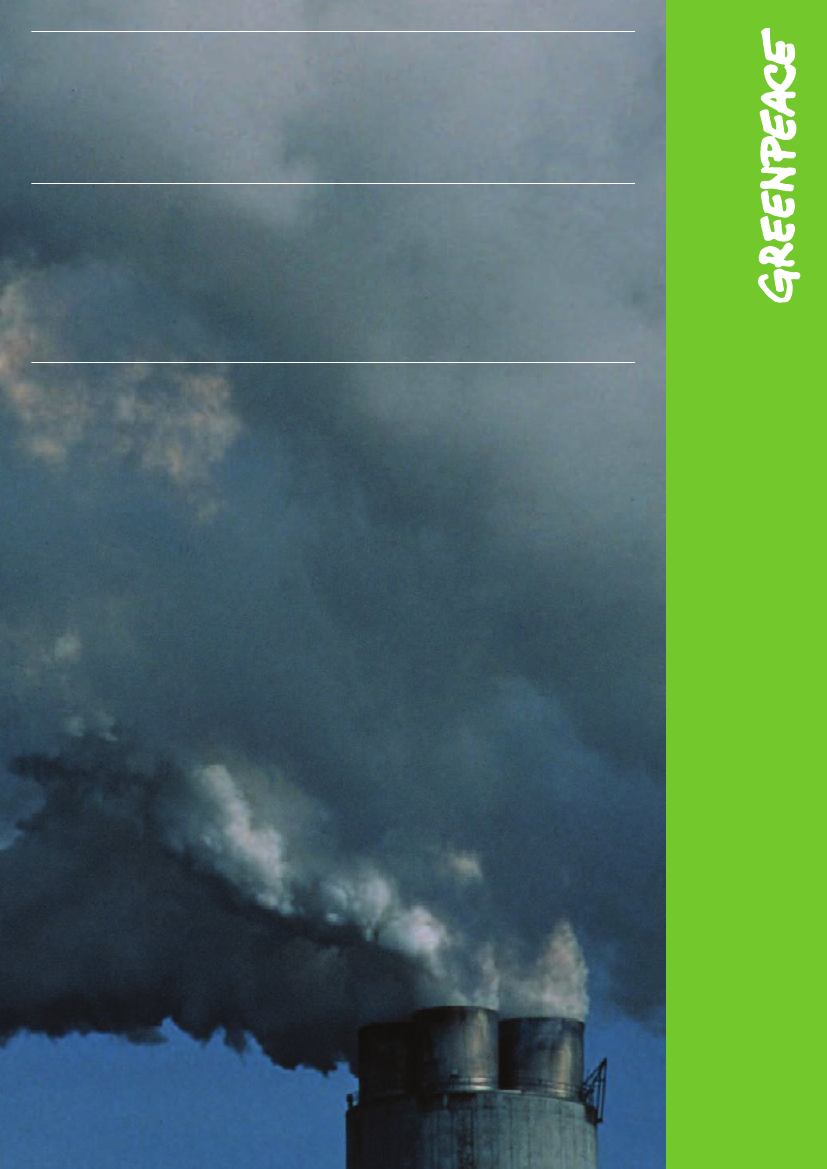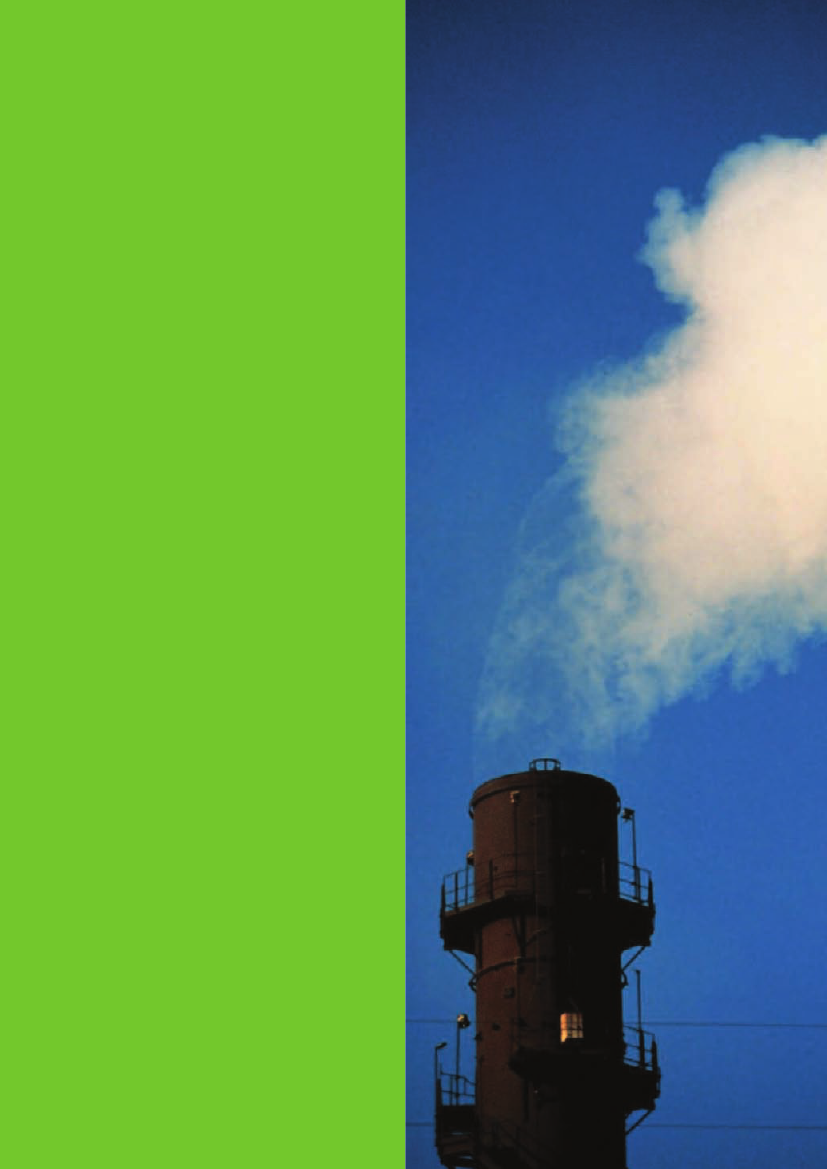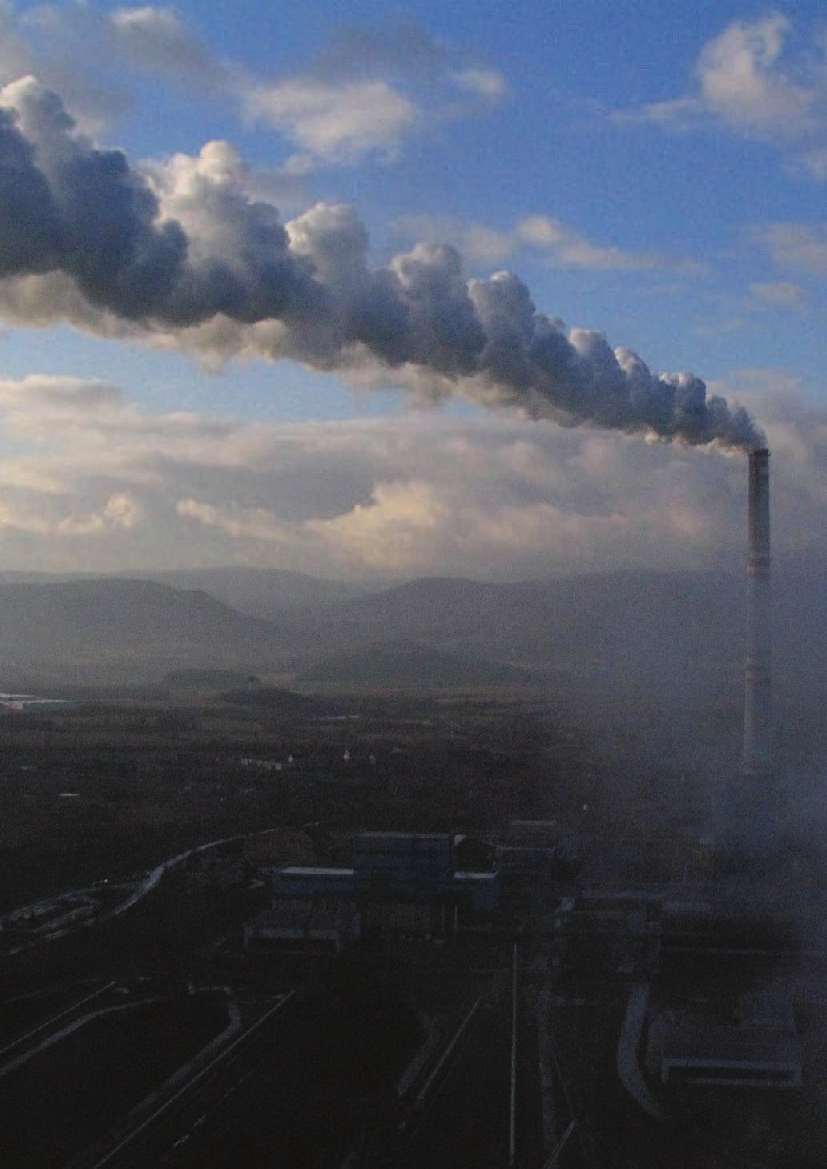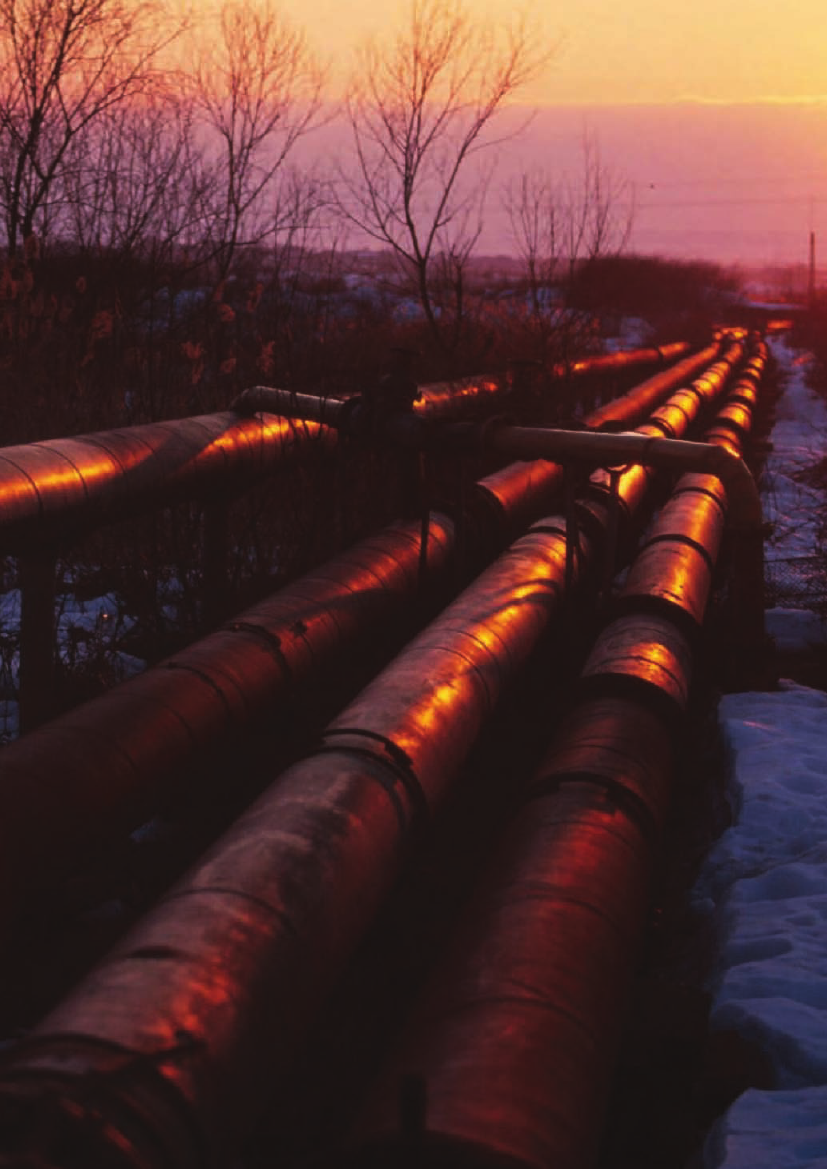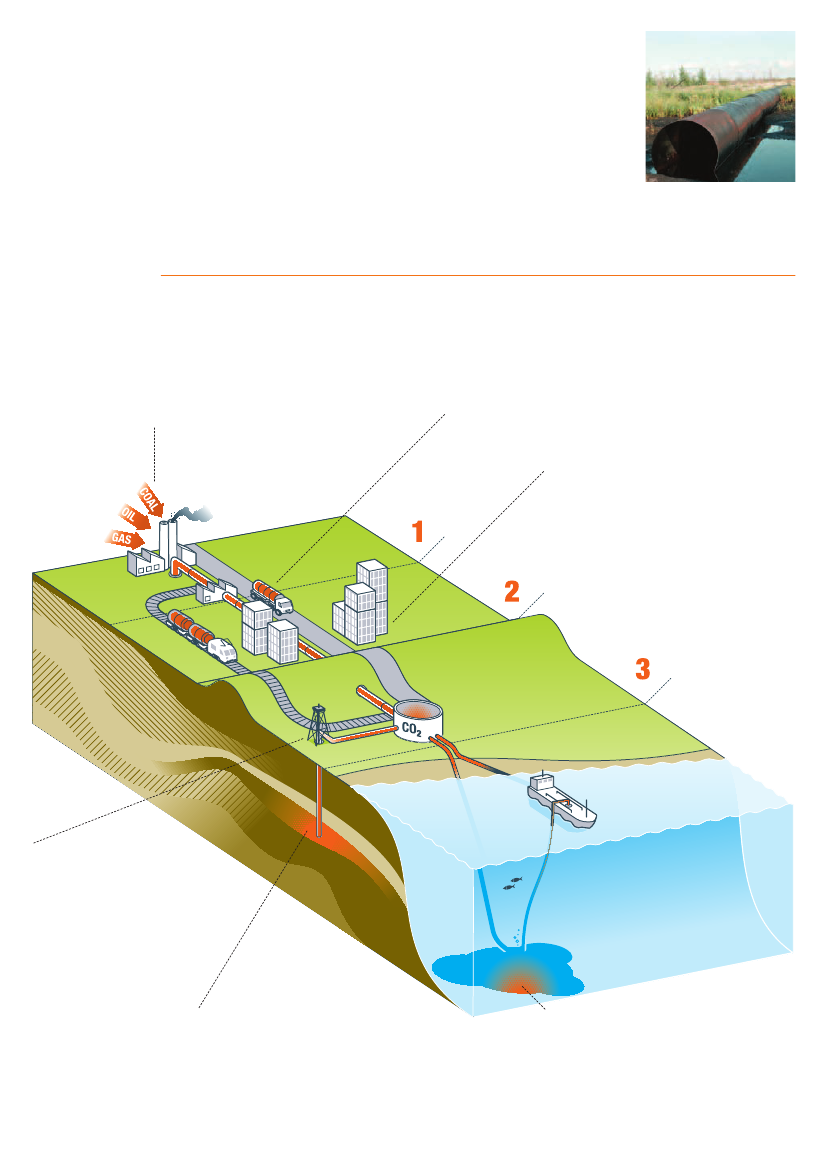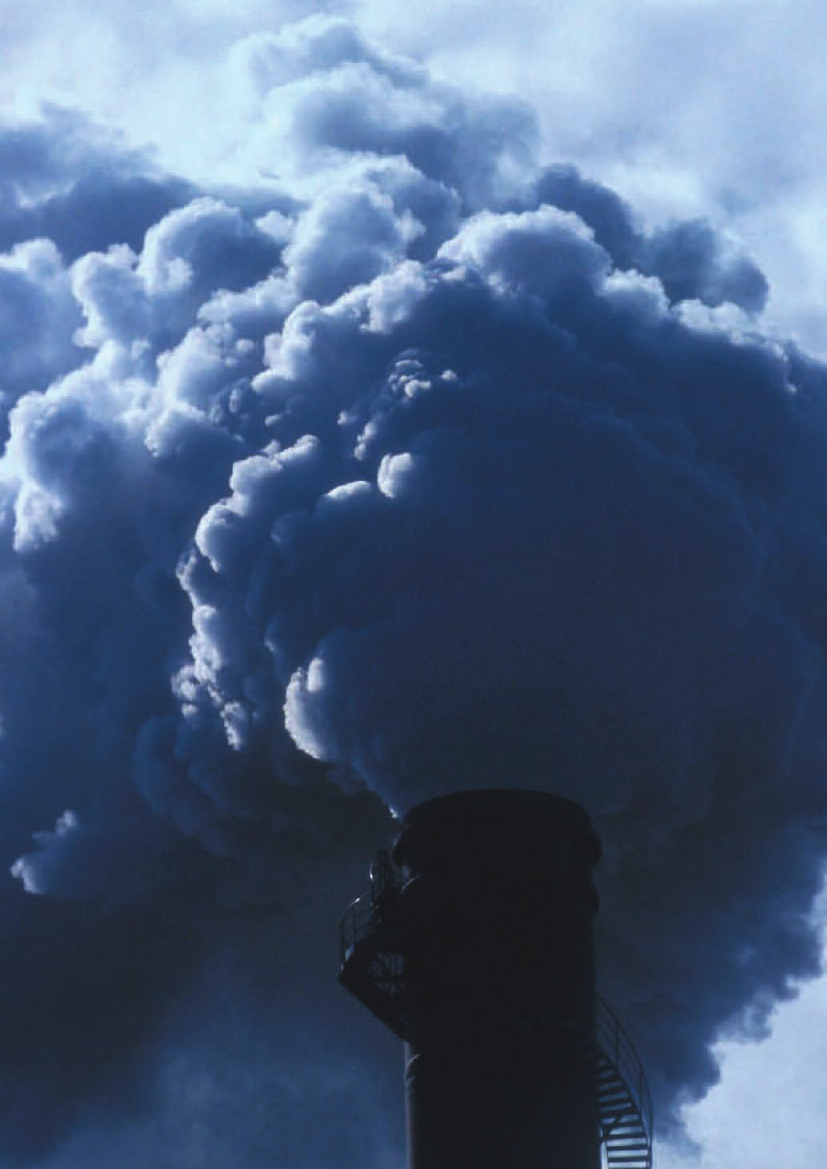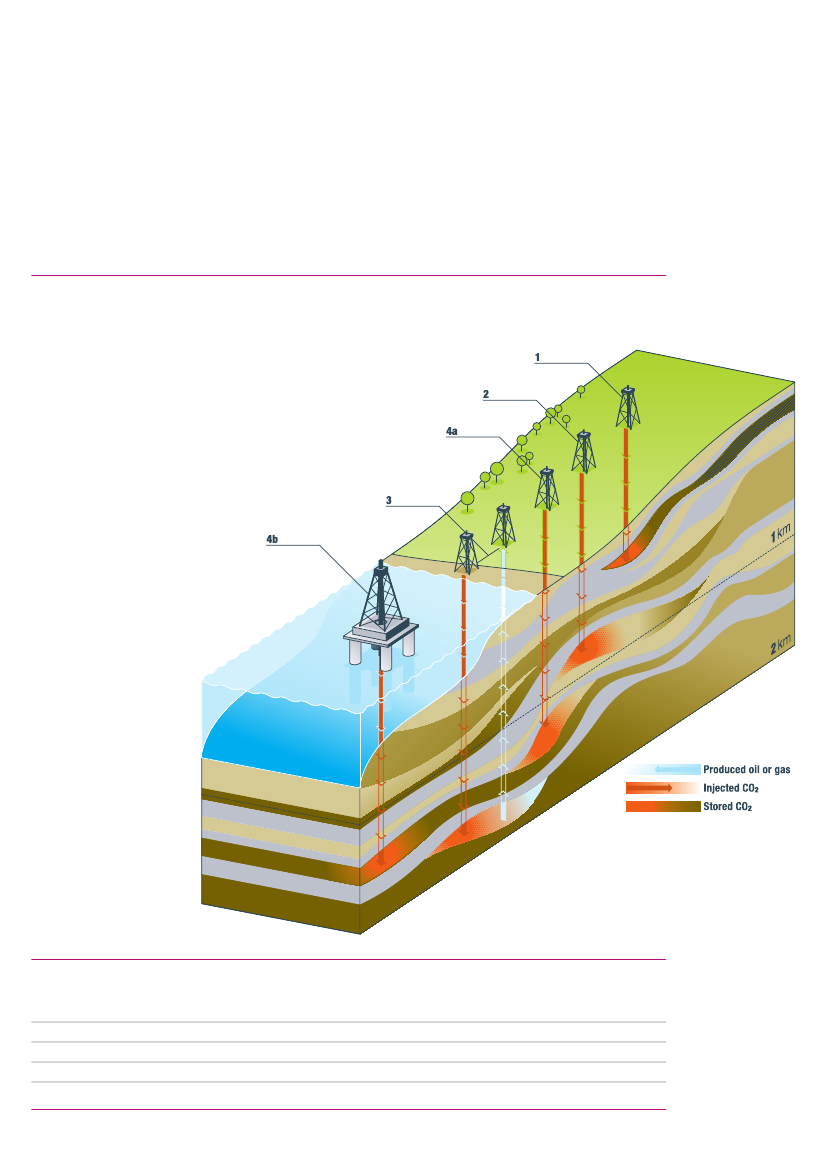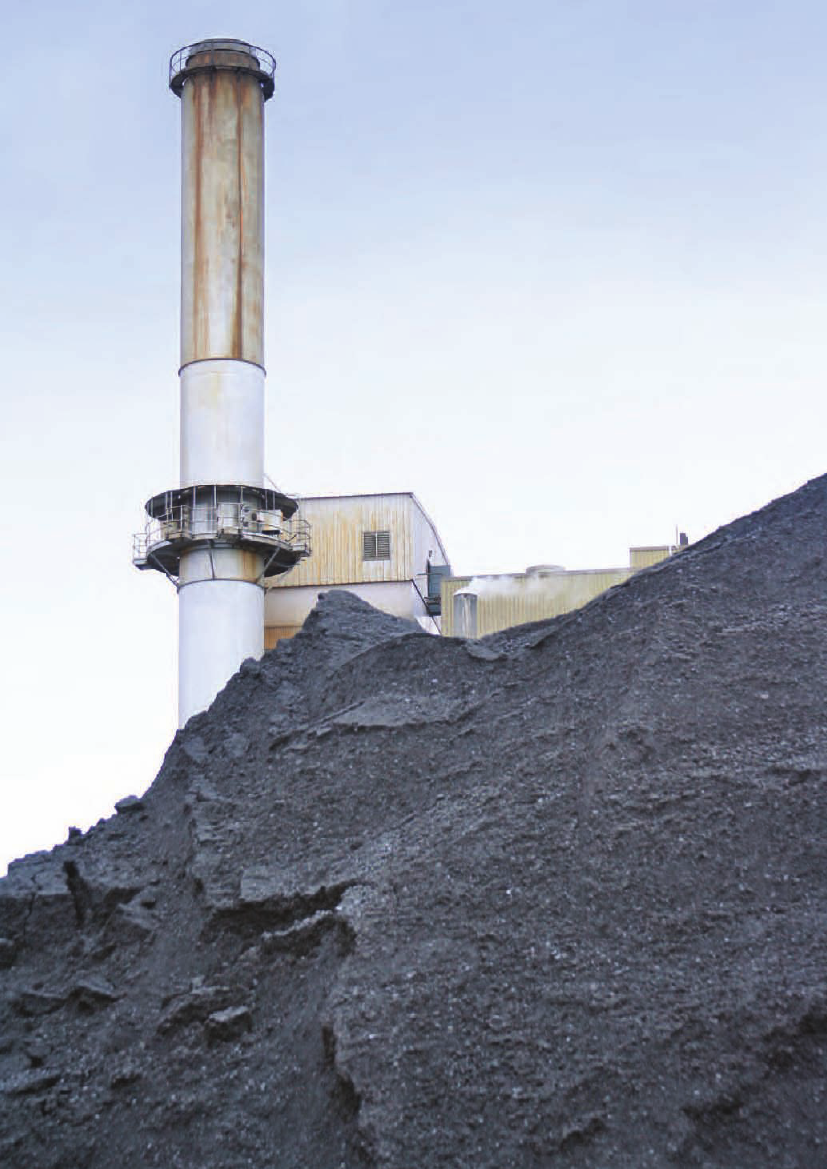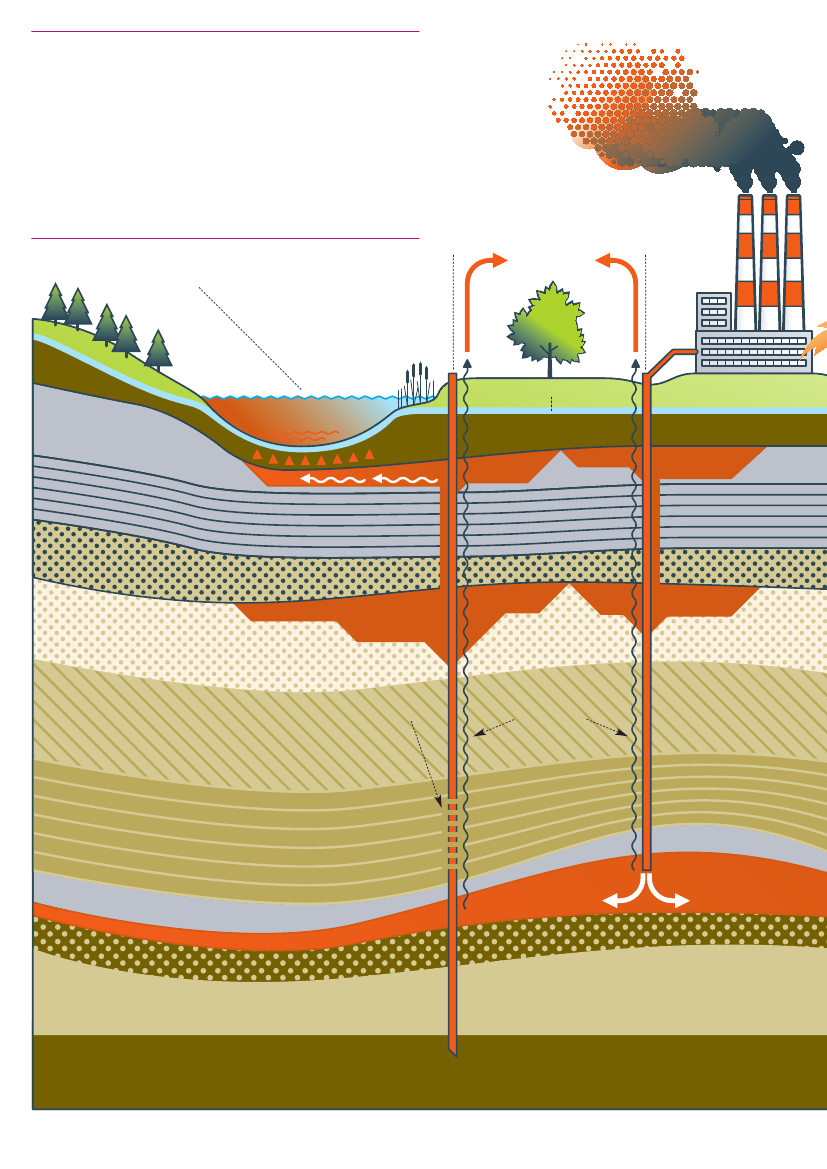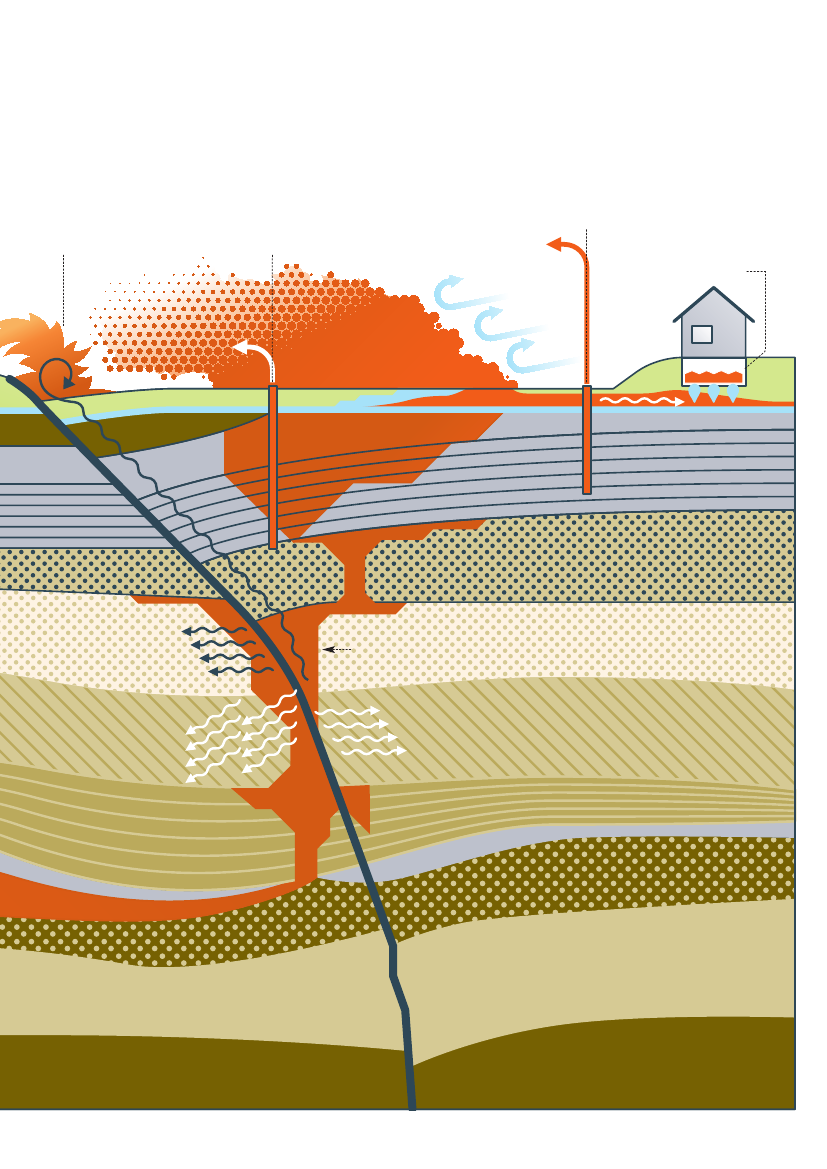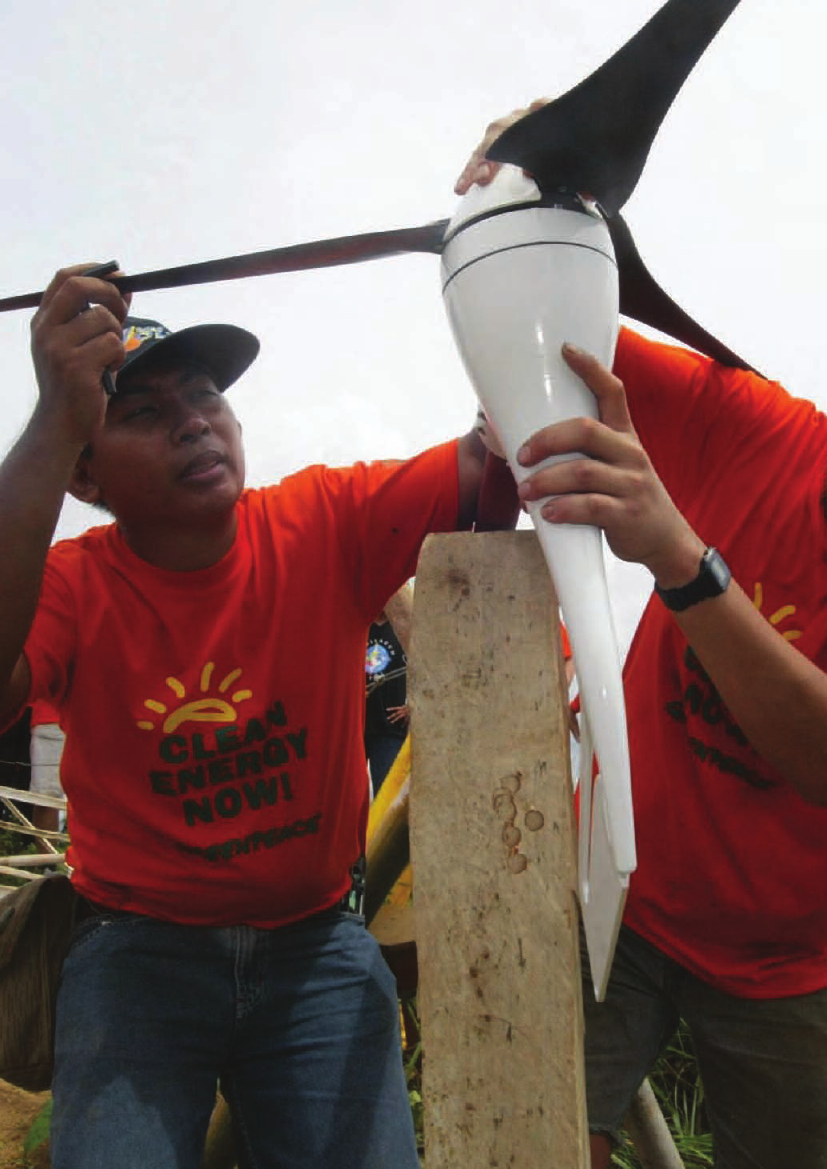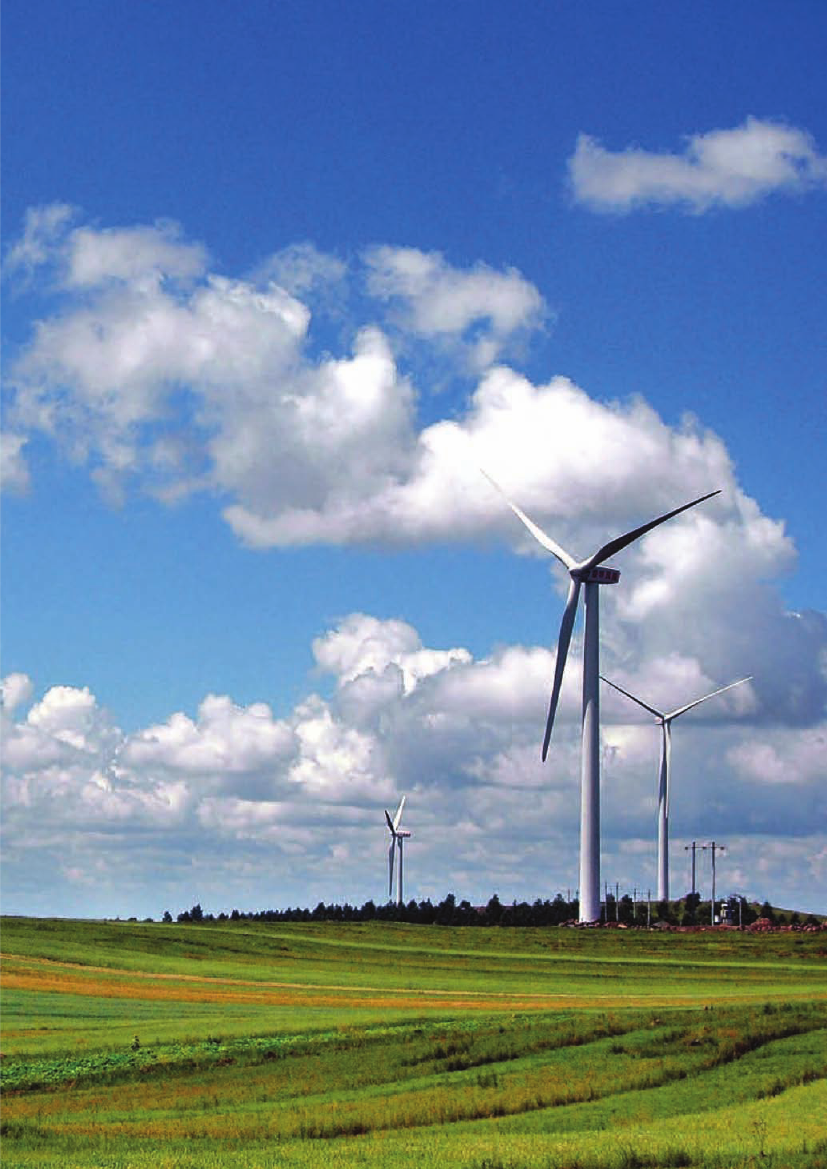Det Energipolitiske Udvalg 2010-11 (1. samling)
L 141 Bilag 4
Offentligt
False HopeWhy carbon captureand storage won’tsave the climate
greenpeace.org
Catalysing an energy revolution
For more information contact:[email protected]Lead Author: Emily RochonEditor: Jo KuperContributing Authors: Dr Erika Bjureby,Dr Paul Johnston, Robin Oakley,Dr David Santillo, Nina Schulz,Dr Gabriela von GoernePrinted on 100% recycledpost-consumer waste withvegetable based inks.JN 136Published in May 2008by Greenpeace InternationalOttho Heldringstraat 51066 AZ AmsterdamThe NetherlandsTel: +31 20 7182000Fax: +31 20 5148151greenpeace.org
Design:neoCommunications for Positive Changewww.neocreative.co.uk
cover imageCogenerationelectric power generation site nearMidland, Pennsylvania, USA.�GREENPEACE / R VISSER
imageSmokestacks fromLTV Steel Co with Cleveland,Ohio, USA.�GREENPEACE / R VISSER
GreenpeaceInternational
False HopeWhy carbon captureand storage won'tsave the climate
ContentsSections1.2.3.4.Executive summaryIntroductionCCS technically speakingLifting the smokescreen591117171921273037List of figures1. Trapping mechanisms15List of tables1. Geological trapping mechanisms2. Geological storage capacity estimates3. Performance of air-blown PC generatingunits with and without CCS4. Impact of CCS system on resourceconsumption and emission rates5. Cost ranges for components of CCS system1520202227
4.1 CCS cannot deliver in time to save the climate4.2 CCS wastes energy4.3 CCS storage – where will all the CO2go,will it stay there permanently?4.4 CCS is too expensive4.5 CCS and liability: risky business5.The world already has the real solutionsto the climate crisis
3
imageView of Prunerov coal-firedpower plant, Czech Republic. Oneof the many sites where Greenpeacehas staged climate change protests.�GREENPEACE / K DAVISON
4
GreenpeaceInternational
False HopeWhy carbon captureand storage won'tsave the climate
SectionOne
1ExecutivesummaryCarbon capture and storage (CCS) aims to reduce the climateimpact of burning fossil fuels by capturing carbon dioxide (CO2)from power station smokestacks and disposing of it underground.Its future development has been widely promoted by the coalindustry as a justification for the construction of new coal-firedpower plants. However, the technology is largely unproven and willnot be ready in time to save the climate.
This report, based on peer-reviewed independentscientific research shows that:CCS cannot deliver in time to avoid dangerousclimate change.The earliest possibility for deploymentof CCS at utility scale is not expected before 2030.1Toavoid the worst impacts of climate change, globalgreenhouse gas emissions have to start falling after 2015,just seven years away.CCS wastes energy.The technology uses between 10and 40% of the energy produced by a power station.2Wide scale adoption of CCS is expected to erase theefficiency gains of the last 50 years, and increaseresource consumption by one third.3Storing carbon underground is risky.Safe andpermanent storage of CO2cannot be guaranteed. Evenvery low leakage rates could undermine any climatemitigation efforts.CCS is expensive.It could lead to a doubling of plantcosts, and an electricity price increase of 21-91%.4Money spent on CCS will divert investments away fromsustainable solutions to climate change.CCS carries significant liability risks.It poses a threatto health, ecosystems and the climate. It is unclear howsevere these risks will be.
The climate crisis requires urgent action. Climate scientistswarn that to avoid the worst effects, global greenhousegas emissions must peak by 2015 and then start falling byat least 50% by 2050, compared to 1990 levels. Coal isthe most polluting of all fossil fuels, and the single greatestthreat to the climate. If current plans to invest hundreds ofbillions of dollars in coal plants are realised, CO2emissionsfrom coal could increase 60% by 2030.Concerns about the feasibility, costs, safety, and liability ofCCS make it a dangerous gamble. A survey of 1000“climate decision-makers and influencers” around theworld reveals substantial doubt in the ability of CCS todeliver. Just 34% were confident that retrofitting ‘cleancoal technology’ to existing power plants could reduceCO2emissions over the next 25 years withoutunacceptable side effects, and only 36% were confidentin its ability to deliver low-carbon energy from new powerstations.5The real solutions to stopping dangerous climate changelie in renewable energy and energy efficiency that can startprotecting the climate today. Huge reductions in energydemand are possible with efficiency measures that savemore money than they cost to implement. Technicallyaccessible renewable energy sources – such as wind,wave and solar- are capable of providing six times moreenergy than the world currently consumes – forever.
5
“CCS will arrive on the battlefield far toolate to help the world avoid dangerousclimate change.”7
Greenpeace’s Energy [R]evolution6provides a practicalblueprint that shows how renewable energy, combinedwith greater energy efficiency, can cut global CO2emissions by almost 50%, and deliver half the world’senergy needs by 2050.What is CCS?CCS is an integrated process, made up of three distinctparts: carbon capture, transport, and storage (includingmeasurement, monitoring and verification).Capture technology aims to produce a concentratedstream of CO2that can be compressed, transported, andstored. Transport of captured CO2to storage locations ismost likely to be via pipeline.Storage of the captured carbon is the final part of theprocess. The vast majority of CO2storage is expected tooccur in geological sites on land, or below the seabed.Disposing of waste CO2in the ocean has also beenproposed but this method has been largely discounted dueto the significant impacts CO2would have on the oceanecosystem and legal constraints that effectively prohibit it.CCS cannot deliver in timeThe urgency of the climate crisis means solutions must beready for large-scale use as soon as possible. CCS simplycannot deliver in time. As the United Nations DevelopmentProgramme (UNDP) says “CCS will arrive on the battlefieldfar too late to help the world avoid dangerous climatechange”8At present, there are no large-scale coal-firedpower plants in the world capturing carbon, let alone anythat are integrated with storage operations.9
The very real danger of “capture-ready” power stations isthat promises to retrofit are unlikely to be kept. Retrofitsare very expensive and can carry such high efficiencylosses that plants become uneconomic.14Furthermore,even if a plant is technically suitable for carbon capturethere is no guarantee that there will be accessiblestorage locations.In the UK, a proposed new coal-fired power plant atKingsnorth, Kent, is being sold as “capture ready”; able toincorporate CCS should the technology ever becomeavailable in the future. However, no one has any idea ifand when this might be. In the meantime, and possibly forits entire lifetime, Kingsnorth (if built) will pump out around8 million tonnes of CO2per year, an amount equivalent tothe total annual CO2emissions of Ghana.15If CCS is ever able to deliver at all, it will be too little,too late.CCS wastes energyCapturing and storing carbon uses lots of energy,anywhere from 10-40% of a power station’s capacity.16Anenergy penalty of just 20% would require the constructionof an extra power station for every four built.17These reductions in efficiencywill require more coal to bemined, transported, and burned, for a power station toproduce the same amount of energy as it did withoutCCS.
CCS will also use more precious resources. Powerstations with capture technology will need 90% morefreshwater than those without. This will worsen watershortages, already aggravated by climate change.18The earliest CCS may be technically feasible at utility scaleOverall, wide-scale adoption of CCS is expected to eraseis 2030.10The Intergovernmental Panel on Climatethe efficiency gains of the last 50 years, and increaseChange (IPCC) does not expect CCS to becomeresource consumption by one third.19commercially viable until at least the second half of thiscentury.11Even then, plants responsible for 40-70% ofStoring carbon underground is riskyelectricity sector CO2 emissions will not be suitable forThe IEA estimates that for CCS to deliver any meaningfulcarbon capture’.12climate mitigation effects by 2050, 6000 projects eachinjecting a million tonnes of CO2per year into the groundDespitethis, CCS is being used as an excuse by powercompanies and utilities to push ahead with plans to build would be required.20At the moment, it is not clear that itnew coal-fired power plants; branding them “capture-will be technically feasible to capture and bury this muchready.” The International Energy Agency (IEA) describes a carbon, i.e. whether there are enough storage sites, or that“capture-ready” plant as one “which can be retrofittedthey will be located close enough to power plants.with CO2capture when the necessary regulatory orTransport of CO2over distances greater than 10013economic drivers are in place”. This definition is broadkilometres is likely to be prohibitively expensive.21enough to make any station theoretically “capture-ready”,and the term meaningless.6
GreenpeaceInternational
imageSmoke stacks of the lignite (browncoal) fuelled Mae Moh power plantdischarging smoke, Mae Moh, Lampangprovince Thailand.
Efforts to capture CO2make no sense if there is notadequate accessible space to store it permanently. Even ifit is feasible to bury hundreds of thousands of gigatonnesof CO2there is no way to guarantee that storage locationswill be appropriately designed and managed over thetimescales required.As long as CO2is in geological sites, there is a risk ofleakage. While it is not currently possible to quantify theexact risks, any CO2release has the potential to impactthe surrounding environment; air, groundwater or soil.Continuous leakage, even at rates as low as 1%, couldnegate climate mitigation efforts.22Remediation may bepossible for CO2leaks, but there is no track record or costestimates for these measures.23A natural example of the danger of CO2leakage occurredat Lake Nyos, Cameroon in 1986. Following a volcaniceruption, large quantities of CO2that had accumulated onthe bottom of the lake were suddenly release, killing 1700people and thousands of cattle over a range of 25 km.24CCS is expensive and undermines fundingfor sustainable solutions
In the US, the Department of Energy has asked for a26.4% budget increase for CCS-related programmes (toUS$623.6 million) while at the same time scaling backrenewable energy and efficiency research by 27.1% (toUS$146.2 million).29Australia has three research centresfor fossil fuels, including one committed to CCS; there isnot one for renewable energy technology.30TheNorwegian government recently committed 20 billionNOK (US$4 billion) for two CCS projects at the expenseof investment in renewable technologies.Spending money on CSS is diverting urgent funding awayfrom renewable energy solutions for the climate crisis.Even assuming that at some stage carbon capturebecomes technically feasible, commercially viable,capable of long-term storage and environmentally safe, itwould still only have a limited impact and would come at ahigh cost. In contrast, as Greenpeace’s Futu[r]eInvestment report shows, investing in a renewable energyfuture would save US$180 billion annually and cut CO2emissions in half by 2050.31CCS and liability: risky business
Large-scale applications of CCS pose significant liabilityWhile cost estimates for CCS vary considerably, one thingrisks, including negative health effects and damage tois certain – it is extremely expensive.ecosystems, groundwater contamination includingCCS will require significant funding to construct the powerpollution of drinking water, and increased greenhouse gasstation and necessary infrastructure to transport and storeemissions resulting from leakage. There is no reliablebasis for estimating the probability or severity of thesecarbon. Existing policy mechanisms, such as a price onrisks. As current regulations are not designed tocarbon, would need to be significantly increased (by asadequately manage them, significant questions as to whomuch as five times higher than their current levels) andis liable remain unanswered32supplemented by additional policy commitments andfinancial incentives.25Industry views liability as a barrier to wider deployment ofCCS33and is unwilling to fully invest in CCS without aThe US Department of Energy (US DOE) calculates thatinstalling carbon capture systems will almost double plantframework that protects it from long-term liability. The riskcosts.26This will lead to electricity price hikes of anywhereis so great that some utilities are unwilling to make CO2between 21 and 91%.27available for storage unless they are relieved of ownershipupon transfer of the CO2off the property of the powerProviding the substantial levels of support needed to getstation.34Potential operators are urging that they onlyCCS off the ground comes at the expense of realretain legal liability for permanently stored carbon for tensolutions. Current research shows electricity generatedyears.35from coal-fired power stations equipped with CCS will bemore expensive than other less-polluting sources, such aswind power and many types of sustainable biomass.28In recent years, coal’s share of research and developmentbudgets in countries pursuing CCS has ballooned.Meanwhile, funding for renewable technologies andefficiency has stagnated or declined.
�GREENPEACE / S YASHWANT
False HopeWhy carbon captureand storage won'tsave the climate
SectionOne
7
A survey of 1000 “climate decision-makers and influencers” aroundthe world reveals substantial doubt about CCS. Just 34% wereconfident that retrofitting ‘clean coal technology’ could reduce CO2emissions over the next 25 years without unacceptable side effects,and only 36% were confident in its ability to deliver low carbonenergy with new power stations. In contrast, 74% expressedconfidence in solar hot water, 62% in offshore wind farms, and 60%in onshore wind farms.36
CCS proponents are demanding almost complete legalprotection from governments, including mechanisms thatcompletely shield operators from legal challenges, transferownership to government and/or limit the amount ofmoney that can be recouped should damage occur.37It isexpected that the public will assume the risk for, and payfor the damages resulting from, CO2storage projects.
Many nations have recognised the potential of these trueclimate solutions and are pressing ahead with ambitiousplans for energy revolutions within their borders. NewZealand plans to achieve carbon neutrality by mid-century. Renewable energy and energy efficiency, notCCS, are leading the way. New Zealand already obtains70% of its electricity from renewable resources and aimsto increase it to 90% by 2025.43In Germany, renewableThe extent of support offered to the recently collapsedenergy use has increased 300% in the past 10 years. InFutureGen project in the US gives some idea of the realthe US, over 5,200 megawatts (MW) of wind energy werecosts of CCS. FutureGen was the Bush Administration’sinstalled in 2007, accounting for 30% of new powerflagship CCS project, a public-private partnership betweeninstalled that year; an increase of 45% in one year.44the US government and industry giants including Rio TintoandAmerican Electric Power Service Corp. FutureGen not The urgency of the climate crisis means solutions must beonly was promised unprecedented public funds (to theready for large-scale deployment in the short-term. CCStune of US$1.3 billion) but was also protected fromsimply cannot deliver in time. The technology is highlyfinancial and legal liability in the event of an unanticipatedspeculative, risky and unlikely to be technically feasible in38release of carbon dioxide, indemnified from lawsuits, and the next twenty years. Letting CCS be used as asmokescreen for building new coal-fired power stations iseven had its insurance policies paid for.39unacceptable and irresponsible. “Capture ready” coalThe world already has the solutionsplants pose a significant threat to the climate.to the climate crisisThe world can fight climate change but only if it reducesInvestment in CCS risks locking the world into an energyits dependence on fossil fuels, particularly coal.future that fails to save the climate. Those technologiesRenewable energy and energy efficiency are safe, cost-with the greatest potential to provide energy security andeffective solutions that carry none of the risks of CCS, andreduce emissions, and to provide renewable energy andare available today to cut emissions and save the climate.energy efficiency, need to be prioritised.Greenpeace’s Energy [R]evolution blueprint shows howrenewable energy, combined with greater energyefficiency, can cut global CO2emissions by almost 50%,and deliver half the world’s energy needs by 2050.40The renewable energy market is booming; in 2007, globalannual investment in renewables exceeded US$100billion.41Decades of technological progress have seenrenewable energy technologies such as wind turbines,solar photovoltaic panels, biomass power plants and solarthermal collectors move steadily into the mainstream. Thesame climate decision-makers who were sceptical aboutCCS believed far more in the ability of renewabletechnologies to deliver reductions in greenhouse gasemissions: 74% expressed confidence in solar hot water,62% in offshore wind farms, and 60% in onshore windfarms.42
8
GreenpeaceInternational
False HopeWhy carbon captureand storage won'tsave the climate
SectionTwo
2IntroductionThis report starts by giving a technical introduction tocarbon capture and storage, explaining the process aswell as the system components. It then details why CCStechnology will not be ready in time to save the climateand also explains how CCS being used as asmokescreen to get the green light to build new coal-firedpower plants. It then moves on to look at how CCStechnology actually wastes energy by making powerplants less efficient.Next, the report considers the substantial challengesrelated to storing massive quantities of CO2undergroundand the fact that safe and permanent storage cannot beguaranteed, as well as the many risks posed by CO2leakage. After this, the report details how large-scaleapplications of CCS are prohibitively expensive andthreaten to undermine investments in renewable energyand energy efficiency measures urgently needed to savethe climate.The report then considers the significant environmental,economic, legal, political, technological and sustainabilityrisks associated with CCS. It details how currentregulations are not designed to adequately managethese, leaving unanswered significant questions as towho is liable.Finally, the report outlines how the world already has thereal solutions to the climate crisis. Greenpeace’s Energy[R]evolution provides a practical blueprint that shows howrenewable energy combined with greater energy efficiencycan cut global CO2emissions by almost 50%, and deliverhalf the world’s energy by 2050.45
9
imagePipeline network in Romania.�GREENPEACE / J HODSON
10
GreenpeaceInternational
False HopeWhy carbon captureand storage won'tsave the climate
SectionThree
3CCS technicallyspeakingThe following review is by no means exhaustive, but is intended toprovide a general understanding of the different stages of carboncapture, transport and storage, as well as the system components.
Pre-combustioncapture systems remove CO2prior tocombustion. This is accomplished via gasification.Gasification of fossil fuels produces a “synthesis gas”(syngas), which is primarily a mixture of carbon monoxide,methane and hydrogen. Before combustion, the syngas isreacted with steam to produce CO2that is then scrubbedAs an integrated process, CCS consists of three distinctfrom the gas stream, usually by a physical or chemicalcomponents: carbon capture, transport and storageabsorption process.47Pre-combustion systems are not a(including measurement, monitoring and verification).mature market technology but are intended forThese components are explained in greater detail below.deployment in conjunction with Integrated Gasificationand Combined Cycle (IGCC) power stations. However,Capturesignificant engineering challenges need to be overcomebefore large-scale integration of coal-based IGCC andBy far the most energy intensive portion of the CCS48process, carbon capture produces a concentrated stream CCS can occur.of CO2that can be compressed, transported, andPost-combustiontechniques are the standard practiceeventually stored. Depending on the process or powerfor removing pollutants, such as sulphur, from the flue gasstation in question, three approaches to capture exist;of coal-fired power stations. Flue gas typically contains uppre-combustion, post-combustion and oxyfuelto 14% CO2, which must be separated either throughcombustion. Pre- and post-combustion capture rates are absorption (chemical or physical), cryogenics ortypically between 85-95% of the CO2emitted, whilemembrane technologies. For CO2capture, chemicaloxyfuel combustion capture rates are nearer to 98%.46absorption with amines, such as monoethanolamine(MEA), is currently the process of choice.49Oncerecovered, the CO2is cooled, dried and compressed fortransport. Post-combustion systems are promoted as apossible carbon mitigation solution for existing coal-firedpower plants worldwide.
CCS aims to capture carbon dioxide resulting fromvarious combustion and industrial processes, and store itunderground or below the sea floor. Its application isproposed for large point sources of CO2, such as fossilfuel power stations.
11
“There is no operational experience withcarbon capture from coal plants andcertainly not with an integratedsequestration operation.”50It is believedthat the earliest CCS might becomefeasible is 2030.51
Oxyfuel combustionburns fossil fuels in 95% pureoxygen instead of air. This results in a flue gas with highCO2concentrations (greater than 80%) that can becondensed and compressed for transport and storage.Substantial issues relating to controlling combustion andthe cost of producing oxygen must be overcome beforethis technology is viable.52To date, this form of carboncapture has only been demonstrated at laboratory andpilot scale (up to 3 MW).53
StorageThe final component of CCS is storage, i.e. the long-termisolation of CO2from the atmosphere. A number of“storage options” and associated techniques are indifferent stages of research and development. Theyinclude methods for ocean and geological storage. Aswell as the actual physical storage of CO2in theselocations, the subsequent measuring, monitoring andverification processes needed to ensure that the integrityof the storage site is maintained are under development.Ocean storageis the disposal of CO2into the watercolumn or at the seabed in deep waters. However, majorconcerns regarding both the efficacy and direct adverseimpacts around the injection site means this approach isnow largely discredited.
TransportOnce CO2has been captured, it needs to be transportedto a storage location. Options for moving the gas fromone location to another include pipelines, ships, rail androad transport. Cost considerations and proximity towater bodies leaves pipelines as the likely choice for mostCCS operations.54
There is no question that oceans serve as natural carbonsinks; CO2in the atmosphere gradually dissolves intoTransporting carbon dioxide via pipelines requirescompression of the gas to a supercritical (dense) or liquid ocean surface waters until an equilibrium is reached.Oceans have absorbed about 500 gigatonnes (Gt) CO2ofstate to reduce its volume. It also requires a dry, purethe total 1,300 GtCO2emitted by human processes instream of CO2to reduce the risk of pipeline corrosion.the past 200 years.61Proponents of ocean storage ofThough mixed wet streams of CO2can be transportedCO2seek to “accelerate” this natural process by injectingthey may require the use of corrosion-resistant steel,CO2directly into the water or directly on the ocean floorwhich is more expensive than the materials typicallyused.55The dangers associated with transporting CO2are via pipelines. However, the storage is not permanent.Once in the ocean, the CO2eventually dissolves,relatively low as it is neither flammable nor explosive.However, CO2is denser than air and tends to pool in low- disperses and returns to the atmosphere as part of theglobal carbon cycle. Some computer models estimatelying, poorly ventilated areas posing a hazard to humanhealth if it reaches concentration levels higher than 3% by that injected CO2would be isolated from the atmospherefor several hundred years at most, with the length ofvolume.56storage dependent on injection depth.62Pipeline transport of CO2is currently used in the US. OverIn addition to lack of permanency, there are many other2500 km of CO2pipelines exist in the western half of thesubstantial concerns with ocean storage. CO2stored incountry where 50 million tons57(Mt)CO2/yr (an amountequivalent to the annual output of about sixteen 500 MW this way cannot be easily monitored or controlled andnegative impacts on the ocean environment due tocoal-fired power stations) is carried to enhanced oilacidification and other changes in ocean chemistry arerecovery (EOR) projects in west Texas and elsewhere.58unavoidable.63Ocean storage remains in research stages,Currently, no such infrastructure exists in Europe.59Theand has not yet been deployed or demonstrated even atconstruction of a dedicated network of pipelines for the64movement of CO2from power stations to disposal sites is pilot scale. International legal instruments, such as theLondon Protocol65and OSPAR Convention, alreadylikely to require a considerable outlay of capital.60effectively prohibit it.
12
GreenpeaceInternational
imageOil spill and pipelines inNizhnevartovsk, West-Siberia
Carbon capture and storage at a glance
Carbon capture is the most energy-intensive part of the process.Carbon capture systems have yet to be applied to a single utility scalecoal-fired power station anywhere in the world. Costs for installationare estimated to result in a near doubling of plant costs. Retrofitscould be even more costly.
CO2can be transported to a storage location via pipelines,ships, rail or road transport. Cost considerations andproximity to water bodies leaves pipelines as the likelychoice for most CCS operations.The construction of a network of pipelines for CCS islikely to require a considerable outlay of capital. Costswill depend on a number of factors. Pipelines built nearpopulation centres or on difficult terrain will be moreexpensive. Costs also increase the further CO2needs tobe transported.port
Ca
pt
ur
e
Trans
Geological storage injects CO2intopermeable rock formations deep belowthe Earth’s surface. The IEA estimatesthat by 2050, at least 6000 storageprojects, each injecting a million tonnesof CO2a year into the ground, need tobe in operation. At present, only threesuch storage projects exist worldwide.
It is not currently possible to quantify the exactrisk of leakage, however any CO2release has thepotential to impact the surrounding environment;air, groundwater or soil. A leakage rate as low as1% could undermine any climate benefit of CCS.
Ocean storage of CO2has largely been ruledout due to unavoidable negative impacts onthe ocean environment from acidificationand other changes in ocean chemistry.
St
ora
ge
13
�GREENPEACE / M LODEWIJKX
False HopeWhy carbon captureand storage won'tsave the climate
SectionThree
Assuming that commercial viability is reached, scenariostudies indicate that by 2050 only 20-40% of globalfossil fuel CO2emissions could be technically suitablefor capture. This includes 30-60% of emissions fromthe power sector.66Therefore, up to 70% of emissionsfrom electricity generation in 2050 may not even betechnically suited to CCS.
Geological storageinvolves the injection of CO2into• Depleted oil and gas reservoirshave a combinationpermeable rock formations sealed by impermeable, denseof water and hydrocarbons in their pore spaces as notrock units (cap rocks) more than 800 metres below theall oil and gas can be recovered during exploitation.Earth’s surface. In practical terms, both onshore andThese reservoirs are probably the best characterised ofoffshore sedimentary formations can serve asall available storage options. The IPCC Special Reportrepositories. Geological storage involves a combination ofon CCS estimates that the technical potential for storagephysical and geochemical trapping mechanisms (seein these reservoirs ranges from 675 to 900 GtCO2.71Table 1). One of these mechanisms involves trapping of• Enhanced oil recoveryinvolves injecting CO2intoCO2as precipitates or in adsorbed phases via reactionsgeological formations to achieve greater oil recovery.with aquifer solids. This process, known as mineralThe best-known CO2– EOR project is located intrapping, is slow, and continues over long time framessoutheastern Saskatchewan, Canada, at the Weyburncompared to solubility trapping (see Figure 1). In this case,Field. This project uses waste CO2piped from athe mechanism of storage involves dissolution or mixinggasification plant in North Dakota. It is the only CO2–of CO2with formation water. When CO2is pumped into aEOR project to date that is being monitored specificallyreservoir it also displaces formation water. The exactto understand CO2storage. At Weyburn, the CO2chemical processes involved depend on both the rockstorage-to-oil production ratio is about one-to-one, onformation and the purity of the CO2stream.a per ton basis.72Over the 25-year lifespan of theproject, it is expected that about 18 million tons of CO2The four types of geological sinks that have received themost attention are: deep saline aquifers, depleted oil andinjected into the ground will yield approximately 130gas reservoirs, enhanced oil recovery and deep coalmillion barrels of oil.73seams.CCS supporters advocate the potential value of this• Deep saline aquifersare porous rock and containform of geological storage as it provides supplementaryvery saline water. Their depth and high concentrationsrevenue streams (through the sale of the recovered oil),of solids means they hold little economic value,lowering the overall cost of the CCS. While this may betherefore they are considered appealing storagetrue for some small projects deployed in the earlylocations. Capacity estimates are highly uncertain butphases of CCS development, “EOR sites are ultimatelymost assume a technical storage potential of at leasttoo few and too geographically isolated to671000 Gt of CO2. The major obstacle to full exploitationaccommodate much of the CO2from widespreadof this storage option is demonstrating that safety andindustrial CO2capture operations.”74Furthermore, asenvironmental protection can be assured.68“Oil fails to pay for CCS”(page 28) shows, EOR is notalways able to offset CCS costs.Since 1996, a deep saline storage project, Sleipner, has• Deep coal seamsare coal deposits that cannot beoperated off the coast of Norway, in the North Sea.mined due to technological or economic constraints.Sleipner is a non-power application of carbon storageCO2is stored in these sites via a gas adsorptionthat strips CO2from natural gas as it is brought up fromthe sea floor and re-injects it into a deep salinemechanism that leads to the release of methane. Thisreservoir, known as the Utsira sandstone formation. TheEnhanced Coal Bed Methane (ECBM) could potentiallyinjection rate for this project is approximately 1 Mt CO2be recovered and used to offset the costs of CCS.69Substantial technical concerns related to the injection ofper year, an amount equal to the CO2emissions from70CO2and subsequent storage processes limit thea typical 150 MW coal-fired power station in the US.immediate attractiveness of these sites.75Technicalstorage capacity is uncertain and could be as little as 3GtCO2or as high as 200 GtCO2.76
14
GreenpeaceInternational
imageHatfield’s Ferry Power Station,located near Masontown, Pennsylvania.
Figure 1Trapping mechanismsThe storage of CO2underground is based on the ability ofphysical and chemical trapping mechanisms to immobiliseCO2permanently and store it forever.Source: IPCC, 2005
100Structural &starigraphictrappingResidual CO2trappingIncreasing Storage Security
Trapping contribution %
SolubilitytrappingMineraltrapping1101001,00010,000
0
Time since injection stops (years)
Table 1Geological trapping mechanismsStructuralWhen CO2is pumped deep underground, it is initially more buoyant than water and will rise upthrough the porous rocks until it reaches the top of the formation where it can become trappedby an impermeable layer of cap rock, such as shale.As CO2migrates through a formation, some of it is retained in pore space by capillary forces.This can immobilise significant amounts of CO2.When CO2dissolves into rock formation water, CO2no longer exists as a separate phase and thebuoyant force that drives it upwards is eliminated. Dissolution is rapid when formation water andCO2share the same pore space.CO2, when dissolved in water, is weakly acidic and can react with minerals in the rock formation.This may result in the conversion of CO2to stable carbonate minerals, the most permanent formof geological storage.
ResidualSolubility trapping
Mineral
Source: IPCC, 2005
15
�GREENPEACE / V LEE HUNTER
False HopeWhy carbon captureand storage won'tsave the climate
SectionThree
imageCementa cement factory,Gotland, Sweden.�GREENPEACE / J CUNNINGHAM
16
GreenpeaceInternational
False HopeWhy carbon captureand storage won'tsave the climate
SectionFour
4Lifting thesmokescreenCCS is not the catch-all climate solution its proponents’ claim, andin any case it is years away from being market-ready. At present“there are still many unanswered questions regarding the safe,socially compatible as well as ecological and economic soundapplications of CCS.”77Energy companies and power utilities tendto gloss over these while proposing to build “capture-ready” plantsthat will exacerbate the climate crisis.
Below are five reasons why CCS should not be acceptedas either justification for building new coal-fired powerplants or for continuing our dependence on coal in thelonger term.
“Capture ready” power stationsProponents of CCS circumvent the fact that thetechnology is not ready, by proposing to build “captureready” power stations. This term refers not to a particulartype of technology but more a state of being for a powerstation. While there is no strict definition of “captureready”, the IEA describes a capture ready plant as “[one]which can be retrofitted with CO2capture when thenecessary regulatory or economic drivers are in place.”81This is sufficiently broad to make any station theoreticallycapture ready, and the term meaningless.The concept of “capture ready” power stations allowsnew coal-fired power stations to be built today whileproviding no guarantee that emissions will be mitigated inthe future. In lieu of delivering a concrete solution tofighting climate change, it banks on the promise of anunproven technology and risks locking us into an energyfuture that fails to protect the climate.In the UK, for example, a proposed new coal-fired powerplant at Kingsnorth, Kent is being sold as “capture ready.”Yet this doesn’t mean that the new plant will be able tocapture and store carbon; it will just be ready toincorporate CCS should the technology ever becomeviable in the future; and no-one has any idea if and whenthis might be. In the meantime, and possibly for its entirelifetime, Kingsnorth (if built) will pump out around 8 million17
4.1CCS cannot deliver in timeto save the climateEvery decision made about new power plants today willinfluence the energy mix of the next 30-40 years. Theurgency of the climate crisis means solutions must beready for large-scale deployment in the short-term. CCSsimply cannot deliver in time.While some system components of CCS are already incommercial use – mostly in the oil and gas industry-“there is no operational experience with carbon capturefrom coal plants and certainly not with an integratedsequestration operation”.78While plans for demonstrationfacilities are underway, it is believed that the earliest CCSmight become feasible is 2030.79The UNDP concludes that CCS “will arrive on thebattlefield far too late to help the world avoid dangerousclimate change.”80
CCS wastes energy and resources.Power plants with carbon capture willuse 10-40% more energy than thosewithout. A 20% increase in the energyrequirement due to carbon capturewould require the construction of anadditional power plant for every fourbuilt to offset the energy loss.
tonnes of CO2per year, an amount equivalent to the totalannual CO2emissions of Ghana.82Recent project cancellations highlight some of thetechnical and economic concerns tied to CCS. In 2007,at least 11 CCS projects were scrapped; plans for newprojects stagnated; and the pace of development forexisting projects slowed considerably.83Most recently,the US DOE pulled out of its flagship CCS project,FutureGen, citing cost concerns (see “USabandons CCSflagship programme”,page 34). Delays and cost over-runs have also led to project cancellations in the UK,Canada, and Norway.The vote of no confidence that CCS received in a surveyof 1000 “climate decision-makers and influencers” fromaround the world is also significant. The survey,conducted by GlobeScan, the World Conservation Union,IUCN and the World Bank, reveals substantial doubtabout CCS. Only 34% of those polled were confident thatretrofitting clean coal technology could reduce CO2emissions over the next 25 years without unacceptableside effects, and only 36% in the ability of ‘clean coaltechnology’ to deliver low carbon energy with new powerstations. In contrast, 74% expressed confidence in theability of solar hot water to deliver, 62% for offshore windfarms, 60% for onshore wind farms, and 51% forcombined heat and power plants.84
Emission reduction potentialEven if CCS were ready, the IPCC notes that deploymentwould only take place if the appropriate subsidymechanisms and policy drivers (including a price oncarbon) were put in place. As a result, it estimates that thebulk of the technology’s adoption would not happen untilthe second half of this century.85Assuming that commercial viability is reached, scenariostudies indicate that by 2050 only 20-40% of global fossilfuel CO2emissions could be technically suitable forcapture86. This includes 30-60% of emissions from thepower sector.87Therefore up to 70% of emissions fromelectricity generation in 2050 may not even be technicallysuited to CCS. Furthermore, this figure does not accountfor the fact that power stations will often be far away fromstorage sites.
In Australia, CCS would lead, at best, to a 9% emissionsreduction in 2030 and a cumulative emissions reductionfrom 2005 to 2030 of only 2.4%.88This is partly due to thelack of suitable storage locations. For example, in theNewcastle-Sydney-Wollongong area of New South Walesand at Port Augusta in South Australia, which togetherproduce about 39% of Australia’s current net CO2emissions from electricity generation, there are noidentified storage sites within 500 km of the coal-firedpower stations.89In comparison, a modest improvementin energy efficiency could – at zero or even negative cost“Capture ready” or not, a coal-fired power station builttoday aggravates the climate crisis. Maintaining the status– decrease emissions in 2030 by about the same amount,and cumulative emissions by twice as much.90quo in the hope that CCS might some day be able todeliver is not a climate mitigation strategy.Climate scientists warn global emissions must peak by2015, just seven years away. CCS is unable to deliver thenecessary greenhouse gas emission reductions to meetthis goal.
18
GreenpeaceInternational
False HopeWhy carbon captureand storage won'tsave the climate
SectionFour
imageGermany's most polluting coalfired power station, RWE brown coalpower plant, Frimmersdorf
4.2CCS wastes energyRelying on CCS to mitigate CO2emissions meansaccepting a 10-40% energy penalty at the power station,depending on the type of technology used.91An energypenalty of just 20% would require the construction of anadditional power station for every four of the same sizebuilt with CCS, to maintain the same net output beforethe CCS was fitted.92
The decision on whether or not to retrofit also hinges on apower station’s proximity to a storage site; the necessaryinfrastructure to deliver the CO2to it; and the availability ofadditional resources, such as water. The numerous coal-fired power stations scheduled to be built between nowand whenever CCS may be ready for commercialdeployment will most likely never have their carboncaptured and will continue to pollute unabated until theyare closed down.
CCS not only cuts energy efficiency but also increasesresource consumption. A study by Rubin et al. (2005),These reductions in efficiency will require more coal to be quantified the impacts of capture systems on plantresource consumption and emission rates. For a 500MWemined, transported and burned to produce the sameamount of energy as power stations without CCS. A new PC unit fitted with carbon capture, a 24% energy penaltywas estimated to have resulted in an increase of500 MWe sub-critical pulverised coal (PC) unit withapproximately 25% for fuel, limestone (for the flue gascarbon capture will have to burn an additional 76,000 kgdesulphurisation system) and ammonia (for nitrogen oxideof coal per hour to maintain the same net output as asimilar sized plant without capture. An ultra-critical PC unit control) inputs (see Table 3).95A US DOE analysis on thewould require a boost in its coal feed rate of 44,000 kg/h freshwater requirements for carbon capture found that in2030, deploying CCS in PC plants with scrubbers and(see Table 2).93CCS would not only worsen fuel securityIGCC plants would increase water consumption in allissues but intensify the major localised environmentalproblems associated with extraction and transport of coal, scenarios examined by 90% (anywhere from 2.2 to 4.3billion gallons of water per day).96In a report for theincluding habitat destruction, damage to rivers andGerman Department for the Environment, the Fraunhoferwaterways and air pollution.Institute estimates that wide-scale adoption of CCS couldPower station efficiency losses would be most pronouncederase the efficiency gains of the last 50 years and increasewhen capture systems are retrofitted to existingresource consumption by one third.97infrastructure. This is because technical mismatchesGreater energy efficiency is half of the solution to tacklingbetween power stations and capture systems meansthe climate crisis. Employing a technology that reducescomponents function below their design capacity levels.the energy efficiency of coal-fired power plants will notThese mismatches are most pronounced with pulverisedbring about the sustainable energy future needed tosub-critical coal units. A study by Alstom Power, Incestimates that the addition of MEA flue gas scrubbing to a protect the climate.500 MWe pulverised coal unit would reduce efficiency by14.5% points (from 35% efficiency to 20.5%) and cost asmuch as US$1600/kWe.94The substantial loss in efficiency,coupled with the high cost of retrofitting these types ofplants, means a large proportion of existing coal powerstations are unlikely ever to be retrofitted for capture.
19
�GREENPEACE / S VIELMO
The IEA estimates that the magnitude ofCO2emissions that need to be capturedand stored by 2050 is on the order of 6000projects, each injecting a million tonnesof CO2a year into the ground. Currently,only three such storage projects existworldwide.98
Table 2Performance of air-blown PC generating units with and without CCSSubcritical PCw/o capturePerformanceGeneratingefficiency (HHV)Coal feed rate, kg/hCO2emitted, kg/hCO2emitted,g/kWe-h*34.3%208,000466,00093125.1%284,00063,60012738.5%185,000415,00083029.3%243,00054,50010943.3%164,000369,00073834.1%209,00046,80094w/captureSupercritical PCw/o capturew/captureUltra-Supercritical PCw/o capturew/capture
Reference plant is 500 MWe, 85% capacity factor; *assumes a 90% capture rateSource: MT, 2007
Table 3Impact of CCS system on resource consumption and emission ratesCapture plant parameterResource consumption(all values in kg/MWh)FuelLimestoneAmmoniaCCS ReagentsSolid wastes/by-productAsh/slagFGD residuesSpent CCS sorbent28.149.6–6.712.24.0539027.50.802.76936.80.192.76Reference plant*RateReference plant with captureIncrease
*Reference plant is a 500 MWe new pulverised coal-fired power station. Energy penalty associated with installation of CCS is assumed to be 24%Source: Rubin et al., 2005b
20
GreenpeaceInternational
imageIndustrial pipeline inPortman Bay, near Cartagena, Spain
4.3CCS storage – where will all the CO2go, will it stay there permanently?Most scenarios for stabilisation of atmospheric CO2levelsbetween 450 and 750 parts per million (ppm) place theeconomic potential of CCS anywhere from 220-2200gigatonnes (Gt)CO2cumulatively.99It is likely that a vastmajority of captured CO2would be disposed of ingeological sites. The challenge of storing manygigatonnes worth of carbon dioxide underground isensuring it stays there. To have any potential climatebenefit, buried CO2must remain underground forever.However, safe, permanent storage cannot be assured;the world has no experience with the deliberate long-termstorage of anything, let alone CO2. The longest runningstorage project, Sleipner in Norway, is only 12 years old.While some geological reservoirs could have the specificcombination of physical features and chemical processesthat trap injected CO2and essentially hold it for all time,there is insufficient data or practical experience to knowwhether there are enough.
The vast majority of these estimates quantify technicalcapacity assuming that the whole of a reservoir isaccessible to store CO2in its pore volume.105This caneasily lead to unrealistically high numbers as the fractionof pore volume that can be used for CO2storage is site-specific and depends on factors such as injection rate,relative permeability, density and mobility of fluids androck heterogeneity.106A geological reservoir withenormous capacity but no injectivity would for example,be included in a technical capacity estimate, even thoughit could never be used.107The technical, regulatory and economic limitations that willalways prevent full usage of storage capacity quicklyreduce capacity estimates. For example, deep salineformations appear to have the greatest storage potential(see Table 4) but several capacity estimates factoring inboth technological and economic constraints put theactual feasible storage capacity at 200-500 GtCO2.108Adding in the limits of co-location of CO2sources andstorage sites (also known as source-to-sink matching)could easily decrease these numbers further and is adeterminant factor.
Costs increase the further CO2needs to be transported.Storage estimatesAustralia’s Commonwealth Scientific and IndustryResearch Organisation (CSIRO) finds “transport of carbonEfforts to capture carbon dioxide make no sense if thereis not adequate space to dispose of it permanently. Global dioxide over distances of more than a hundred kilometrescan become prohibitively expensive... Unless the cost cananthropogenic CO2emissions are close to 26 Gt100be significantly reduced, it will not be feasible to pipeannually and growing at a rate of about 0.5 % per109annum.101From a purely technical perspective, estimates carbon dioxide long distances”. High quality storagesites are of no use if the source of CO2is too far awayexcluding economics and transport factors indicate thatfrom them. Current estimates clearly fail to portray thethere is enough capacity to store CO2emissions forseveral decades, up to several hundreds of years.102Deep realistic storage capacity available for CO2sequestration.saline aquifers are believed to have the greatest potential,followed by depleted oil and gas fields, and coal seams.The Massachusetts Institute of Technology’s (MIT)TheFuture of Coalreport, however, notes that there is a greatdegree of uncertainty associated with storage estimates.While most “support the contention that sufficient capacityexists to store many 100’s to many 1000’s of Gigatonnes ofCO2… this uncertain range is too large to inform sensiblepolicy.”103This stems from the use of inappropriatemethodology, lack of reliable data and the diverse nature ofgeological settings. There is very little of the informationneeded to assess the majority of the potential storagereservoirs available; national level estimates are largelybased on modelled average values and therefore remain asource of considerable uncertainty.10421
�GREENPEACE / M ANGEL GREMO
False HopeWhy carbon captureand storage won'tsave the climate
SectionFour
Overview of geological storage options1. Deep coal seamsIn these formations, CO2is stored via a mechanism that leads to the release of methane.Substantial technical concerns related to the injection of CO2and subsequent storage processeslimit the immediate attractiveness of these sites.2. Depleted oil and gas reservoirsThese reservoirs tend to be the best characterised of all available storage options.However, the multiple bore holes and wells drilled to find and extract oil and gascan increase the leakage risk for storage operations.3. Enhanced Oil Recovery (EOR)EOR involves injecting CO2into geologicalformations to achieve greater oil recovery.EOR sites are ultimately too few and toogeographically isolated to accommodate muchof the CO2from widespread capture operations.4. Deep saline formations(a) onshore (b) offshoreDeep saline aquifers are porousrock, which contain very salinewater. The major obstacles to fullexploitation of this storage optionare accurate characterisationand demonstration that safetyand environmental protectioncan be assured.
Table 4Geological storage capacity estimatesReservoir typeDeep saline formationsOil and gas fieldsDeep coal seamsSource: IPCC, 2005
Range (GtCO2)1000-uncertain, but possibly 10,000675-9003-200
22
GreenpeaceInternational
False HopeWhy carbon captureand storage won'tsave the climate
SectionFour�GREENPEACE / K DAVISON
imageThe Philippines biggestcoal-fired power station, Sual, in theprovince of Pangasinan.
In the report, the first storage option considered is RoseRun sandstone, a deep saline formation, very close to theAchieving the substantial CO2emissions reductionsCO2sources. Though its proximity is ideal, the site hasrequired to avoid catastrophic climate change wouldmany problems including limited storage capacity, lowrequire broad deployment of CCS in a relatively shortpermeability and questionable integrity (i.e. high risk ofperiod of time. Global emissions from coal are currentlyleakage).115The second storage option examined includes2.5 Gt of carbon per year. Sequestering just 1 Gt ofa combination of coal beds and depleted oil and gascarbon (3.6 Gt of CO2) would require the injection offields in the area. Further away than Rose Run, these sitesapproximately 50 million barrels of supercritical CO2perwould have limited utility. The coal beds lack sufficientday from about six hundred 1000 MWe coal plants.110Thestorage capacity and the practicality of storing CO2in coalIEA estimates that the magnitude of CO2emissions thatseams is virtually untested. The oil and gas fields also lackneed to be captured and stored by 2050 is in the order ofsufficient capacity, and leakage is a concern mostly due6000 projects each injecting a million tonnes of CO2ato the numerous boreholes drilled to extract fossil fuelsyear into the ground.111The vast infrastructure required tofrom them in the first place.116The third storage option iscapture and transport CO2from diverse and widelythe Mt. Simon formation, appealing because it is bothdistributed point sources would also need to be built.larger and less fractured than the Rose Run location.Distance, however, is a limiting factor; Mt. Simon wouldIn the US alone, reducing CO2emissions from therequire the construction of pipelines with an averageelectricity sector could require 200 projects, each withlength of 374km.117injection rates ten times bigger than Sleipner.112The USDOE estimates the country has enough technical capacityWhen scaling up CCS from demonstration phases, suchto store CO2for tens to hundreds of years.113However, ascenarios are likely to be repeated many times over.recent Congressional Research Services report showsthat on the ground realities complicate the picturesubstantially. The report examines several scenarios forpipeline development in a seven-state region. The modelscenario considered CO2emissions from the 11 largestCO2sources, all coal-fired power stations.114
Scaling up
23
Sequestering just 1 Gt of carbonwould require the injection ofapproximately 50 million barrels ofsupercritical CO2per day from aboutsix hundred 1000 MWe coal plants.118
For example, a CCS experiment in Texas (see“Storingcarbon underground can have unintendedStoring CO2underground is predicated on the ability ofconsequences”,page 26) found CO2injected into salinephysical and chemical trapping mechanisms to immobilisesedimentary aquifers caused carbonates and otherCO2permanently, and store it forever. Trappingminerals to dissolve rapidly. This could allow CO2andmechanisms work in different ways and at different rates,brine to leak into the water table.123from low-permeable cap rocks serving as physicalbarriers to CO2movement, to dissolving CO2into water.119While it is not currently possible to quantify the exact riskThe former mechanism is immediately effective, while the of leakage, any CO2release has the potential to impactlatter can take thousands of years to complete. Thethe surrounding environment; air, groundwater or soil.efficiency of trapping mechanisms depends on theMost computer models suggest leakage will occur fastest“migration rate of the CO2, which itself is highly dependent in the first 50-100 years of a project’s lifetime, beforetrapping mechanisms take effect. Others indicate that littleon the rock and fluid properties and geologicalhappens in the first 1000-year period with leakage mostcharacteristics of each site”.120This means that eachlikely to occur over the following 3000 to 5000 yearstorage site would need to undergo detailedperiod.124Either way, even a tiny rate of leakage couldcharacterisations both to determine suitability, as well asto assess the likelihood of leakage.undermine any putative climate benefit of CCS. A leakagerate of just 1% on 600 Gt of stored carbon (2160 GtCO2As long as CO2is present in geological formations, thereor about 100 years’ worth of CO2emissions from fossilis a risk of leakage – it can migrate laterally or upwards tofuels), could release as much as 6Gt of carbon (21.6the surface. In contact with water, CO2becomesGtCO2) per year back into the atmosphere. This is roughlycorrosive and can compromise the integrity of cap rocks,equivalent to current total global CO2emissions from fossilwell casings and cement plugs. Undetected fractures infuels.125Remediation may be possible for CO2leaks butcap rocks or those created by injecting CO2at too high athere is no track record or cost estimates for these sortspressure can provide another avenue for CO2to escape.of measures.126Improper design and construction of wells can also createopportunities for leakage.121The implications for climateThe absence of a reliable risk management method is ofmitigation as well as the other environmental and publicconcern,asleakage risks remain after the closure of anhealth risks make leakage a serious concern.injection site. Monitoring would be required for longperiods after closure, possibly forever. Therefore,Preventing leaks will largely rely upon careful technologyappropriate tools to detect and protect against leaks willchoices, project design, plant operation and reservoirbe essential.selection. The IPCC notes that the fraction of CO2retained in “geological reservoirs is very likely to exceed99% over 100 years and is likely to exceed 99% over1000 years”.122However, these findings are only valid forwell-selected, fully characterised, properly designed andmanaged storage locations. At the moment, sufficientcapacity in high quality reservoirs cannot be assured, norcan their appropriate design and management beguaranteed. It is likely that some CO2storage will occur inlower quality sites, without proper management. In thesecases, the risk of leakage could be even greater.
CO2leakage
24
imageCoal Energy Power Plant�JOSEPPI / DREAMSTIME.COM
25
Case Study
Storing carbon undergroundcan have unintended consequencesOne of the key challenges for CCS isthe safe and permanent storage ofcaptured carbon. Even very smallleakage rates could completelyundermine any climate mitigationefforts.The world has no experience of thelong-term storage of anything, letalone CO2.As the results of a 2006 UnitedStates Geological Survey (USGS) fieldexperiment1show, there is everychance that carbon dioxide willbehave in ways that are totallyunexpected. The USGS scientistswere testing deep geological disposalof carbon dioxide at a pilot project inFrio, Texas.The researchers were surprised whenthe buried CO2dissolved largeamounts of the surrounding mineralsresponsible for keeping it contained.The CO2reacted with salty water(brine) in the geological formationturning it as acidic as vinegar. Thisacidified brine then dissolved otherminerals, including metals such asiron and manganese, organic materialand relatively large amounts ofcarbonate materials. Carbonatesnaturally seal pores and fractures ingeological sites; the reaction of theacidic brine with them is extremelyconcerning. Carbonate is also foundin the cements used to plugabandoned oil and gas wells. If theseopen, CO2could leak into theatmosphere and/or the contaminatedbrine could leak into the aquifers thatsupply drinking and irrigation water.In an interview with Greenpeace, leadscientist Yousif Kharaka warned thatthe results are “a cautionary note: fordetailed and careful studies ofinjection sites, and a well thought outmonitoring program to detect earlyleaks of CO2into shallow potablegroundwater or to the atmosphere.”2The results of the UGCS study showthat we simply do not know enoughabout how stored carbon will behaveto be able to assure its safe andpermanent storage.
1
Kharaka Y K, Cole D R, Hovorka S D, Gunter W D, Knauss K G & Freifeld B M, ‘Gas-water-rock interactions in frio formation following CO2injection:Implications for the storage of greenhouse gases in sedimentary basins’, Geology, vol., 34, no. 7, 2006, pp. 577–580.Kharka, Yousif, 2007, USGS, Research Hydrologist, Interview conducted over e-mail.
2
26
GreenpeaceInternational
False HopeWhy carbon captureand storage won'tsave the climate
SectionFour
imageBlast furnaces of LTV Steel Co,Cleveland, Ohio, USA.
4.4CCS is too expensiveCost estimates for CCS vary considerably depending onfactors such as power station configuration, CCStechnology, fuel costs, size of project and location. Onething is certain, CCS is expensive. It requires significantfunds to construct the power stations and necessaryinfrastructure to transport and store carbon. The IPCCsets costs between US$15-75 per ton of capturedCO2.127A recent US DOE report found installing carboncapture systems to most modern plant technologiesresulted in a near doubling of plant costs.128Such costsare estimated to increase the price of electricity anywherefrom 21-91%.129For transport, pipeline networks will need to be built tomove CO2to storage sites. The construction of a networkof pipelines for CCS is likely to require a considerableoutlay of capital.130Costs will vary depending on anumber of factors, including pipeline length, diameter andspecific steel components (corrosion-resistant) as well asthe volume of CO2to be transported. Pipelines built nearpopulation centres or on difficult terrain (such as marshyor rocky ground) are more expensive.131The IPCCestimates a cost range for pipelines between US$1-8/tonof CO2transported (see Table 5).132A United StatesCongressional Research Services report calculated capitalcosts for an 11-mile (18 km) pipeline in the midwesternpart of the country at approximately US$6 million. Thesame report estimates that a dedicated interstate pipelinenetwork in North Carolina would cost upwards of US$5billion due to the limited geological sequestration potentialin that part of the country.133
Storage and subsequent monitoring and verification costsare estimated to range from US$0.5-8/tCO2injected andUS$0.1-0.3/tCO2injected, respectively.134The overall costof CCS could serve as another barrier to itsdeployment.135EOR has been suggested as a way tooffset the costs but as“Oil fails to pay for CCS”(page 28)shows, in reality this is questionable.136CCS diverts resources away from real solutionsIn recent years, the share of research and developmentbudgets in countries pursuing CCS has ballooned, withCCS often included as part of renewable energypackages. Meanwhile, funding for real renewabletechnologies and efficiency has stagnated or declined.The US DOE’s fiscal year 2009 budget seeks a 26.4%increase (US$493.4 million in FY 2008 vs. US$623.6million in FY 2009) in funding for CCS-relatedprogrammes, at the same time it is scaling backprogrammes tied to renewable energy and efficiencyresearch and cutting budgets by 27.1% (US$211.1 millionin FY 2008 vs. US$146.2 million in FY 2009).137Australiahas three cooperative Research Centres for fossil fuels,one particularly committed to CCS. There is not one forrenewable energy technology.138In Norway, petroleum-based research receives over fivetimes more funds than renewable energy research. Arecent commitment of more than 20 billion NOK (US$4billion) for two CCS projects aimed at capturing 2 MtCO2annually (see”How CCS has crippled the Norwegianenergy debate”,page 29) further widens the gap.
Table 5Cost ranges for components of CCS systemCCS system componentsCapture from coal –or gas-fired power plantTransportGeological storageMonitoring and verificationSource: IPCC 2005
Cost rangeUS$15-75/tCO2net capturedUS$1-8/tCO2transportedUS$0.5-8/t CO2net injectedUS$0.1-0.3/tCO2injected
RemarksNet costs of captured CO2compared tothe same plant without capturePer 250 km pipeline or shipping for mass flow rates of5 (high end) to 40 (low end) MtCO2/yrExcluding potential revenue from EOR or ECBMThis covers pre-injection, injection, and post-injectionmonitoring, and depends on the regulatory requirements
27
�GREENPEACE / R VISSER
Case Study
Oil fails to pay for CCSEven if CCS were available, largeapplications are prohibitivelyexpensive. EOR is often proposed asa way round this. Its proponentsargue that the profits from therecovered oil will cover the costs ofcarbon capture.In 2005, when production in theBritish Miller oil and gas field becameuneconomic, BP sought governmentsubsidies to initiate an EOR project.With EOR the life of the oil field couldhave been extended by up to 20years, delaying the costlydecommissioning process andallowing access to an estimated 57million barrels of currentlyunrecoverable oil.2The Norwegian governmentabandoned a similar project after theStatoil-Hydro and Shell companieswithdrew. The companies argued thatalthough CCS would probably betechnically feasible, it would nevermake economic sense. Building theCCS technology would have meantclosing oil production for a year, andcompletely modifying the facilities.Overall, oil production would onlyhave increased by 2%4nowhere nearenough to cover the costs ofinstalling the CCS technology.EOR is one of the main waysproposed by industry to make CCSaffordable, yet as the above caseshighlight, projects are often unlikely tobe able to cover the costs. FundingCCS is an extremely unwiseinvestment.
However, not only are EOR sites toofew and far between to accomodatemuch carbon from widespread CCSoperations,1the cancellation of CCS-EOR projects due to associated costs The potential profits from theand low returns show it is not always recovered oil, however, could notable to offset the extra costs.make up the difference between thecost of carbon using CCS (€38 pertonne), and the current price ofcarbon credits (€21 per tonne, inthe EU).3
BP tried to convince the UKgovernment to bridge the gap, askingfor a tax break of over 50%, and aguaranteed subsidised rate of return.When the UK government decidedthat all proposed CCS projects had tocompete for funding and tax relief, BPcancelled its plans.
12
Hannnegan, B, 2007, pg 25Shepherd & Wedderburn, ”Carbon Capture and Storage: The Race is On”, http://www.shepwedd.co.uk/knowledge/article/779-1610/carbon-capture-and-storage-the-race-is-on/current/, retrieved 23.1.08.http://pointcarbon.comTaz.de, ”CO2-Injektion ist kein Geschäftsmodell”, http://www.taz.de/index.php?id=archiv&dig=2007/07/03/a0140, retrieved 23.1.08
34
28
GreenpeaceInternational
False HopeWhy carbon captureand storage won'tsave the climate
SectionFour
How CCS has crippledthe Norwegian energy debateDespite the fact that Norwaygenerates nearly 100% of itselectricity from renewabletechnologies, State funding forrenewable energy research is lessthan one-sixth of that received bythe petroleum industry.1Over the last decade CCS has cometo dominate the energy debate inNorway, diverting resources andpolitical attention away fromrenewable generation and energyefficiency measures. Though theNorwegian Parliament recentlyannounced an increase in the totalfunding for renewable energyresearch, CCS is considered partof this2.Recently, the Norwegian governmentcommitted to cover all additionalconstruction and operation costs toensure carbon capture and storagefrom two natural gas-fired powerplants on the Norwegian west coast,Kårstø and Mongstad. This has beenestimated to amount to more than20 billion NOK (US$4 billion) overtheir lifetimes.3The highly controversial Kårstø plant,which emits around 1 million tonnesof CO2per year, began operating inNovember 2007. High gas costs andlow electricity returns mean the planthas hardly been in operation. Full-scale carbon capture was promisedfrom 2009 but is now postponed to2012. Significant technologicalconstraints will likely push back thedate even further. The capture plant,the pipeline to a storage location andthe storage process control facilityhave yet to be built.4Given how much better the samemoney could have been spent onother climate and energydevelopment projects, the head ofthe Norwegian Institute for EnergyResearch (IFE), called the decision torush development of the Kårstø plant“close to immoral.5”At the Mongstad refinery, known asthe “European CCS test centre”, twopilot plants using different captureprocesses (amine and carbonate) areunder construction, the aim ofcapturing 100,000 tonnes of CO2peryear from 2011. Yet, until 2014 at theearliest, they will simply release thecaptured CO2back into theatmosphere. This is because thepipelines to the storage sites are notdue to be finished until 2014. In factthey may well not even be ready bythen, as potential delays ininvestment decisions threaten topostpone their completion.6In Norway, as in other countriespursuing CCS, the technology isfailing to deliver on its promises.Renewable energy and energyefficiency are safe, cost-effectivesolutions to tackling climate change.Given the urgency of confronting theclimate crisis, halting development ofthese technologies in favour ofwaiting for CCS really is immoral.
1234
Article based on Norwegian Research Council figures; http://www.klassekampen.no/49135/mod_article/item/nullClimate white paper agreement http://www.stortinget.no/diverse/klimaforlik.htmlKårstø report: http://nve.no/modules/module_111/news_item_view.asp?iNewsId=32570&iCategoryId=1604Rapport nr 13, CO2-håndtering på Kårstø, Norges vassdrags- og energidirektorat, Olav Falk-Pedersen, Mari Hegg Gundersen, Asle Selfors and PålTore Svendsen. December 2006. Pages 31 and 42. http://www.nve.no/FileArchive/388/NVErapport13-06_b.pdfComment to NRK radio 31.01.2008. See background statement, where they suggest a more stepwise strategy, athttp://www.ife.no/ife_nyheter/2007/IFE_nei_til_CO2-haandtering_pa_Kaarstoe/view?set_language=no&cl=noTechnology Weekly, “Frykter store forsinkelser på Kårstø”, http://www.tu.no/energi/article148205.ece, retrived 03.04.08
5
6
29
A US DOE report found installing carboncapture systems to most modern planttechnologies resulted in a near doublingof plant costs.139Such costs areestimated to increase the price ofelectricity anywhere from 21-91%.140
On a local scale, CO2leakage from storage sites poses athreat to human health. CO2is denser than air andtherefore tends to pool in low-lying, poorly ventilatedCCS and liability: risky businessareas posing a hazard if it reaches levels higher than 3%by volume.143This risk also applies to pipeline transport ofCCS carries significant environmental, economic, legal,CO2through populated areas, raising critical issues withpolitical, technological and sustainability risks. First is thedanger that new coal plants are approved and built on the regard to route selection, overpressure protection, andleak detection.144basis of being “capture-ready”, but never have thetechnology installed. Secondary risks arise from the largeA natural example of the danger of CO2leakage occurredquantities of CO2to be injected, the prolonged storagein a volcanically active area at Lake Nyos in Cameroontimes required for any real climate benefit, and the factin 1986. Large quantities of CO2that had accumulatedthat injection wells, and other infrastructure and geologicalon the bottom of the lake were suddenly released, killingimperfections, may result in CO2leakage.1700 people and thousands of cattle over a range of25 km.145Environmental risksCO2rising to the shallow subsurface can have lethaleffects on plants and subsoil animals and contaminate•Reservoir leakage: the slow, long-term release of CO2groundwater. Soil acidification and suppression of rootfrom storage sites, for example through geologicalzone respiration has been reported in volcanic andfaults;earthquake zones. In Mammoth Mountain, California, the•Sudden catastrophic leakage: the large-scale release of release of CO2following several small earthquakes killed100 acres of trees.146Migration of CO2can acidify watersCO2from storage sites, for instance through failures ofand mobilise toxic heavy metals. Its injection can buildactive or abandoned injection wells;pressure, displace brines and cause seismic activities.147•Escape of CO2and associated substances into shallowGreater environmental damage due to increased fossil fuelgroundwater;extraction is another risk. The higher power demands of•Displacement of brines and mobilisation of toxic metals plants using carbon capture require higher coal and otherand organics moving upwards leading to contamination fossil fuel use. Thus the major localised environmentalof potable water, overlying sediments, soils or seawater; problems associated with extraction and transport offossil fuels including habitat destruction, damage to rivers•Escape of other hazardous captured flue gases.and waterways (from subsidence due to longwall mining),and air pollution will also increase.The specific environmental risks associated with CO2leakage can be divided into two catergories: global andlocal. On a global scale, continuous leakage of CO2hasthe potential to undermine climate change mitigationefforts. While some leakage may be acceptable, it isgenerally agreed that it can only be tolerated within certainlimits.141Even leakage rates as low as 1% per year couldbe too high. Leakage at this rate would reduce a givenquantity of stored CO2to 37% of the original amount after100 years.142Environmental risks of geological CO2storage include:
4.5
30
GreenpeaceInternational
imageBig oil spill, dead trees,pipelines in Nizhnevartovsk,West Siberia
Liability risksLarge-scale applications of CCS pose significant liabilityrisks. Current regulations are not designed to adequatelymanage these, leaving unanswered significant questionsas to who is liable.148At a minimum, any CCS regulatoryregime would need to address: capture; transport; sitecharacterisation and permitting; operating standards,including monitoring, measurement and verification andremediation plans; crediting of mitigated CO2; andmeasures to deal with long-term storage. In theformulation of such a framework, industry’s best interests(limitation of liability and costs) may run counter to publicbest interest (safety over unlimited timescales).Industry views liability as a barrier to wider deployment ofCCS149and is unwilling to fully invest in CCS unless it isprotected from the risks associated with long-term CO2storage. The risks are so great that many utilities areunwilling to make CO2available for storage unless theyare relieved of ownership upon transfer of the CO2fromthe power station.150Potential operators are urging thatthey only retain legal liability for permanently storedcarbon for 10 years.151Many factors impact the scope of liability associated withCCS. Just a few examples include the classification andpurity of captured CO2, definition of property rights andownership of injected CO2. Captured CO2can, forexample, be labelled as a resource, waste product oreven hazardous waste. The latter designations triggerstricter regulatory regimes for the handling, transport anddisposal of CO2and increase the price of CCS.152Another issue is the purity of the CO2stream. CapturedCO2often contains various by-products of combustionprocesses such as nitrogen oxides (NOx) and sulphurdioxide (SO2) as well as trace heavy metals including lead,mercury and cadmium.153Allowing injection of mixedstreams underground is appealing as they require lessscrubbing at the plant level, reducing costs. However,permitting the disposal of non-CO2components alters therisk profile of geological storage as well as the regulatoryand legal responses.154For example, co-storage of CO2with sulphur dioxide (SO2) increases the risk of leakagedue to its chemical properties. In contact with water, SO2forms the highly corrosive sulphuric acid that more readilydissolves materials, such as the cement used to sealwells. A greater risk of leakage means higher likelihood ofdamage and liability. How much SO2, if any, to allow incaptured CO2streams will need to be determined.
Regulations will have to account for its more corrosivenature in pipeline transport and long-term storage, inorder to minimise risk.155Perhaps the most critical questions relate to propertyrights and who is liable for the captured CO2, particularlyonce the respective CCS project stops operating. Theanswer will determine who pays for any damage causedby CCS. Potential risks include liability for (1) health effectsand damage to ecosystems from surface leakage; (2)groundwater contamination, including pollution of drinkingwater; (3) induced seismicity; and (4) climate effects fromincreased greenhouse gas emissions through surfaceleakage. To limit the liability of those engaged in CCSactivities, liability caps, federal indemnity programmes anda complete transfer of liability from the private to publicsector has been proposed.156These mechanismscompletely shield operators from legal challenges, transferownership to government and/or limit the amount ofmoney that can be recouped should damage occur.Some argue that such measures are necessary asprojects will be unable to secure financing or insurancewithout them.157The recently collapsed FutureGen project in the US, forexample, (see“US abandons flagship CCS programme”page 34) was protected from financial and legal liability inthe event of an unanticipated release of carbon dioxide.158Lawmakers also agreed to indemnify FutureGen fromlawsuits and pay for insurance policies to cover the plant.159
31
�GREENPEACE / M LODEWIJKX
False HopeWhy carbon captureand storage won'tsave the climate
SectionFour
Leakage pathways and potential impacts of CO2escapeA number of leakage pathways could result in the migration of CO2into the surroundingenvironment. They include leakage through or along injection wells, abandoned wells,undetected faults or those created by injecting CO2at too high a pressure, corrosion ofcap rocks and cement plugs used to seal injection wells and diffusion into shallowergeologic formations. Potential consequences of leakage are equally broad. Releases ofCO2back into the atmosphere would undermine any climate benefit of geologicalstorage; CO2rising into the subsurface could negatively impact soil ecosystems, harmingboth flora and fauna; CO2contamination of surface waters might negatively impactaquatic ecosystems; leakage into groundwater aquifers could degrade their quality bymobilising toxic metals and dissolving other minerals; and human health impacts are aconcern should concentrations of CO2reach levels higher than 3% by volume.Source: Benson, S, 2006
Accumulation in water ofdeep, stably stratified lake
Oilwell
CO2direct to air
CO2injectionwell
WetlandsWater tableLakeVadose zone
PlumeDiffusion
Plume
PlumePlume
Casing corrosion
Annular flow
Cap rock
CO2
CO2
32
GreenpeaceInternational
False HopeWhy carbon captureand storage won'tsave the climate
SectionFour
Accumulationin topographicdepression
Abandonedwell
ShallowgroundwaterwellOff-gas from wellAccumulationin basement
CO2
CO2plume
Diffusion
Plume
CO2dissolved ingroundwater
Separate phase CO2
CO2in low permeabilityenvironment
Diffusion
CO2
33
Case Study
FutureGen – US abandonsCCS flagship programmeFutureGen, the flagship of the BushAdministration’s CCS programme,was hailed as a first-of-its-kind near-zero emission coal plant1. Yet, inJanuary 2008, following repeateddelays and chronic cost overruns, theUS government pulled the plug onFutureGen, stating "when a projectdoubles in cost, it's the time to sitdown and rework those agreements."2Announced in 2003, FutureGen wassupposed to be online by 2012 butnever left the development phase.The public-private partnership behindthe project included the US DOE andcorporate giants American ElectricPower Service Corp., AngloAmerican, BHP Billiton, Rio Tinto, andChina's largest coal-based powercompany, China Huaneng Group.Federal government support forFutureGen was to be supplementedby a generous package from theState of Illinois. This included a $17million grant, a sales tax exemptionon building materials and selectedequipment, and $50 million set asidefor below-market-rate project loans.The State also passed a law toprotect FutureGen from financial andlegal liability in the event of anunanticipated release of carbondioxide.3Lawmakers also agreed toindemnify FutureGen from lawsuitsand pay for insurance policies tocover the plant.4In 2007, the DOE reassessed theproject design after costs had risenby 85% in three years to $1.8 billion.5The Department, orginally slated tocover 74% of the costs, askedindustry to assume more of thefinancial burden to “prevent furthercost escalation”7. However, the headof FutureGen estimated that everymonth of delay cost the project $10million; “solely due to inflation”.8What happens to FutureGen now isunclear. Industry partners, promisedtheir costs would be capped at $400million, will have to finance itthemselves to continue. This seemshighly unlikely given how much theproject relied on public financing andliability.FutureGen collapsed despite beingpromised an unprecedented level ofsupport; a total of US$1.3 billion ofpublic funds, and being shielded fromany legal responsibility. The debacleshould serve as a stark warning togovernments and industryconsidering investing in CCS.
12
FutureGen Alliance, http://www.futuregenalliance.org/faqs.stm, retrieved 11.03.08
Helenair.com, “Senators press official on carbon projects”, http://www.helenair.com/articles/2008/02/01/national/100na_080201_carbon.txt, retrieved27.02.08.Illinois Department of Commerce and Economic Opportunity, “Gov. Blagojevish Appluads the Passage of Important Legislation to Continue Illinois’Strong Bipartisan Push to Bring FutureGen to Illinois”, http://www.ildceo.net/dceo/News/pr07262007-2.htm, retrieved 23.1.08.Gatehouse News Service, “Mattoon gets FutureGen nod, but hurdles remain”,http://www.gatehousenewsservice.com/regional_news/midwest/illinois/x1414531785, retrieved 23.1.08.US Department of Energy, “Statement from US Department of Energy Acting Principal Deputy Assistant Secretary for Fossil Energy James Slutz”,http://www.energy.gov/news/5779.htm, retrieved 23.1.08USA Today, “Emissions-free coal plant’s costs worries feds”, http://www.usatoday.com/money/industries/energy/2008-01-06-futuregen_N.htmretrieved 23.1.08.US Department of Energy, “Statement from US Department of Energy Acting Principal Deputy Assistant Secretary for Fossil Energy James Slutz”,http://www.energy.gov/news/5779.htm, retrieved 23.1.08USA Today, “Emissions-free coal plant’s costs worries feds”, http://www.usatoday.com/money/industries/energy/2008-01-06-futuregen_N.htmretrieved 23.1.08.
3
4
5
6
7
8
34
GreenpeaceInternational
imageCementa cement factory,Gotland, Sweden.
Financial risksImmense amounts of money have already been spentsupporting fossil-fuel power plants that are the maincontributors to climate change. Implementation of CCSwould require governments not only to continue butaugment this support with additional subsidies and policydrivers. CCS adoption will only be possible with extremelyheavy incentives. The technology is very expensive, andthere are no guarantees that it will ever work. Economicanalysis of absolute costs for CCS is characterised by ahigh level of uncertainty. For power stations, the IPCCestimates a range of US$14 to $91 per tonne of CO2avoided for the entire CCS process.160A more recentassessment placed the cost of merely capturing the CO2anywhere from €24-75 per tonne CO2avoided.161Carbon emission cap-and-trade schemes have beenpromoted by CCS supporters as a way to lower the costbarriers of technology adoption.162However, in order forCCS to be profitable, the price for carbon emissions wouldhave to be even higher than the additional costs associatedwith deploying the technology. Current CO2market pricesof around €21 per tonne as well as future projections forthe 2008-2012 period of the Emissions Trading Schemeare insufficient to spur deployment of CCS.163Prices ashigh as €100 per tonne might be needed to support initialprojects.164However,not even a high price on carbon isenough to ensure a future for CCS.165To make projects viable, however, carbon prices wouldneed to be coupled with additional policy commitmentsand financial incentives.166Additional mechanismsproposed to supplement carbon prices include directinvestment support, loan guarantees and public-privatepartnerships.167Instead of polluters being asked to pay forthese programmes, deployment of CCS envisages ascheme where governments, and ultimately taxpayers,pay polluters to try not to pollute. If costs turn out to behigher than expected, the conditions for commercialviability may never be met and the money spent will havebeen wasted.
Providing the substantial levels of support to get CCS offthe ground raises a serious question about priorities whencurrent research shows that electricity generated fromcoal equipped with CCS will be more expensive thanother less polluting sources, such as gas, wind power andmany types of sustainable biomass. It is also much moreexpensive than increasing energy efficiency.168Evenassuming that, at some stage, carbon capture becomestechnically feasible, capable of long-term storage,environmentally safe and commercially viable, its impactwould be limited and come at a high cost.Meanwhile, as Greenpeace’s Futu[r]e Investment report169shows, investing in a renewable energy futurewould saveUS$180 billion annually and cut CO2emissions in halfby 2050.
35
�GREENPEACE / J CUNNINGHAM
False HopeWhy carbon captureand storage won'tsave the climate
SectionFour
imageTour around the South East of Asia topromote the use of clean energy, Manila, Philippines.�GREENPEACE / K DAVISON
36
GreenpeaceInternational
False HopeWhy carbon captureand storage won'tsave the climate
SectionFive
5The world alreadyhas the real solutionsto the climate crisisThe promise of CCS diverts attention away from sustainable energysolutions and risks locking the world into an energy future that failsto save the climate. Priority should be given to investments inrenewable energy and energy efficiency which have the greatestpotential to provide energy security and reduce emissions.
Greenpeace’s Energy [R]evolution scenario provides apractical blueprint that shows how renewable energy,combined with greater energy efficiency, can cut globalCO2emissions by almost 50%, and deliver half the world’senergy by 2050.170Decades of technological progresshave seen renewable energy technologies such as windturbines, solar photovoltaic panels, biomass power plantsand solar thermal collectors move steadily into themainstream. The market for renewable energy is growingdramatically; in 2007 global annual investment inrenewables exceeded US$100 billion.171At the sametime, there is enormous potential for reducing ourconsumption of energy, even while providing the samelevel of “energy services”.Many nations have recognised the potential of these trueclimate solutions and are pressing ahead with ambitiousplans for energy revolutions within their borders. NewZealand plans to achieve carbon neutrality by mid-century. Renewable energy and energy efficiency, notCCS, are leading the way. New Zealand already obtains70% of its electricity from renewable resources and aimsto increase it to 90% by 2025.172In Germany, renewableenergy supply has increased 300% in the past 10 years.
New legislation will require all homes built after 1 January2009 to install renewable energy heating systems.173Inthe US, over 5,200 MW of wind energy were installed in2007, accounting for 30% of new power installed thatyear; an increase of 45% in one year.174These are just afew examples of the renewable energy boom.The urgency of the climate crisis means solutions must beready for large-scale deployment in the short term. CCSsimply cannot deliver in time. The technology is highlyspeculative, risky and unlikely to be technically feasible inthe next 20 years. Allowing CCS to be used as asmokescreen for building new coal-fired power stations isunacceptable and irresponsible. “Capture-ready” coal-fired power plants pose a significant threat to the climate.To tackle the climate crisis, the world needs to reduce theamount of CO2produced, not bury it underground andhope that it stays there. Dirty energy sources, such ascoal, must be phased out while investments in sustainableenergy solutions must be increased. Renewable energyand energy efficiency are safe, cost-effective solutionsthat carry none of the risks of CCS and are available nowto cut emissions and save the climate.
37
6ReferencesAbanades, J C et al., 2005.Summary for PolicymakersinIPCCSpecial Report on Carbon Dioxide Capture and Storage,B. Metzet al., Editors. 2005, Cambridge University Press: Cambridge, U.K.Azar, C et al, 2006,Carbon Capture and Storage from FossilFuels and Biomass – Costs and Potential Role in Stabilizing theAtmosphere,Climactic Change vol. 74, 2006, pp. 47-79.Bachu, S et al., 2007.CO2storage capacity estimation:Methodology and gaps,International Journal of Greenhouse GasControl I, 2007, pp. 430-443.Benson, S, 2004.Carbon Dioxide Capture and Storage inUnderground Geologic Formations,Lawrence Berkley NationalLaboratory, Berkeley 2004,<http://www.pewclimate.org/docUploads/10-50_Benson.pdf>.Benson, S, 2006.Liability Issues Related to Geological Storageof CO2.Lawrence Berkley National Laboratory. Presentation forWRI Workshop on Carbon Capture and Storage Liability,Washington, DC, September, 2006.’Benson, S et al., 2005.Underground Geological StorageinIPCCSpecial Report on Carbon Dioxide Capture and Storage,B. Metzet al., Editors. 2005, Cambridge University Press: Cambridge, U.K.Bradshaw, J et al., 2007.CO2storage capacity estimation:Issues and development of standards,International Journal ofGreenhouse Gas Control 1, 2007, pp. 62-68.Bruant, R, et al., 2002.Safe Storage of CO2in Deep SalineAquifers,Environ. Sci. and Technol. vol. 36, issue 11, 2002,pp. 240a-245a.Carbon Capture Journal (CCJ), 2008.Only 34% confidence inclean coal- climate decision-makers.Keith Forward, Editor.January/February 2008, Issue 1.Doctor, R et al., 2005.Transport of CO2inIPCC Special Reporton Carbon Dioxide Capture and Storage,B. Metz et al., Editors.2005, Cambridge University Press: Cambridge, U.K.Energy Information Administration (EIA), 2007.The InternationalEnergy Outlook 2007,US Department of Energy, Washington,DC, May 2007,< http://www.eia.doe.gov/oiaf/ieo/pdf/0484(2007).pdf>.Forbes, S, 2002.Regulatory Barriers for Carbon Capture Storageand Sequestration.National Energy Technology Laboratory,November 2002.Gough, C & Shackley, S, 2006.Towards a Multi-CriteriaMethodology for Assessment of Geological Carbon StorageOptions, Climactic Change74, 2006, pp. 141-174.Groenenberg, H & de Coninck, H, 2007.Technological supportfor an enabling policy framework for carbon dioxide capture andgeological storage, Task 3: Incentivising CO2capture and storagein the European Union,April 2007.Hannegan, B, 2007. Testimony for Hearing of the Science,Technology and Innovation Subcommittee of the Committee onCommerce, Science, and Transportation. 110thCong., 1st Sess.7 November 2007.Heddle, G et al., 2003. TheEconomics of CO2Storage,MIT,August 2003,< http://sequestration.mit.edu/pdf/LFEE_2003-003_RP.pdf>.Herzog, H & Golomb, D, 2004.Carbon Capture and Storagefrom Fossil Fuel Usein Energy Encyclopaedia, C. Cleveland,Editor. 2004. Elsevier: Amsterdam, Netherlands.International Energy Agency (IEA) Greenhouse Gas R&DProgramme, 2007a.CO2capture ready plants,2007/4, May 2007.
Damen, K et al., 2006. Healthy,Safety and Environmental Risks ofInternational Energy Agency (IEA), 2007b.Near-termUnderground CO2Storage – Overview of Mechanisms and Current Opportunities for Carbon Dioxide Capture and Storage,GlobalAssessments Workshop in Support of the G8 Plan of Action,Knowledge.Climactic Change, vol. 74, 2006, pp. 289-318.June 2007.de Figueiredo, M et al., 2005.Framing the Long-Term In SituIPCC, 2005.Carbon Dioxide Capture and Storage: SpecialLiability Issue for Geologic Carbon Storage in the United States,Report of the Intergovernmental Panel on Climate Change,IPCC,Mitigation and Adaptation Strategies for Global Change vol. 10,Geneva 2005,2005, pp. 647-657.<http://arch.rivm.nl/env/int/ipcc/pages_media/SRCCS-final/Diesendorf, M, 2006.Can geosequestration save the coalSRCCS_WholeReport.pdf>.industry?,in J Byrne, L Glvoer & N Toly (eds),Transformingpower: Energy as a social project,Energy and EnvironmentalPolicy Series vol. 9, 2006, pp. 223-248.
38
GreenpeaceInternational
False HopeWhy carbon captureand storage won'tsave the climate
SectionSix
Johnston, P. & Santillo, D., 2003.Carbon Capture andSequestration: Potential Environmental Impacts.Proceedings ofIPCC Workshop on Carbon Dioxide Capture and Storage,Regina, Canada 18-21 November 2002, publ. Energy ResearchCentre of the Netherlands (ECN): 95-110.
Saddler, H, et al., 2004,Geosequestration: What is it and howmuch can it contribute to a sustainable energy policy forAustralia?,The Australia Institute, Anu, 2004.Shuster, E et al., 2007.Estimating Freshwater Needs to MeetFuture Thermoelectic Generation Requirements,2007, NationalEnergy Technology Laboratories: Pittsburgh, PA.
Kharaka Y et al., 2006.Gas-water-rock interactions in frioformation following CO2injection: Implications for the storage ofSpreng, D et al., 2007.CO2capture and storage: Anothergreenhouse gases in sedimentary basins,Geology, vol. 34, no. 7,Faustian Bargain?Energy Policy, vol. 35, 2007 pp. 850-854.2006, pp. 577–580.Thambimuthu, K et al., 2005.Capture of CO2inIPCC SpecialLevinson, Marc, 2007.Carbon Capture and Sequestration,TheReport on Carbon Dioxide Capture and Storage,B. Metz et al.,London Accord, JP Morgan, 2007.Editors. 2005, Cambridge University Press: Cambridge, U.K.<http://www.london-accord.co.uk/final_report/ reports/pdf/c6.pdf>The Interstate Oil and Gas Compact Commission, 2007.Massachusetts Institute of Technology (MIT), 2007.The Future ofStorage of Carbon Dioxide in Geologic Structures: A LegalsCoal,MIT, Boston 2007,and Regulatory Guide for States and Provinces.Task Force on< http://web.mit.edu/coal/The_Future_of_Coal.pdf>.Carbon Capture and Geologic Storage, September 2007.McFarland, J et al., 2000.Economic Modeling of the GlobalUnited Nations Development Programme (UNDP), 2007.Adoption of Carbon Capture and Sequestration Technologies,inAvoidingDangerous Climate Change: Strategies for Mitigation,Proceedings of the Sixth International Conference of GreenhouseHuman Development Report 2007/2008.Gas Control Technologies. Editors J Gale and Y Kaya, 2000.United Nations Foundation, 2007.Confronting Climate Change:National Energy Technology Laboratory (NETL), 2006.Avoiding the Unmanageable and Managing the Unavoidable,International Carbon Capture and Storage Projects Overcoming<http://www.unfoundation.org/SEG/>.Legal Barriers.NETL, June 2006,US Department of Energy (US DOE), Office of Fossil Energy,< http://www.netl.doe.gov/energy analyses/pubs/2007.Carbon Sequestration Atlas of the United States andCCSregulatorypaperFinalReport.pdf>.Canada,2007.National Energy Technology Laboratory (NETL), 2007,Cost and<http://www.netl.doe.gov/technologies/carbon_seq/refshelf/atlas/>.Performance Baseline for Fossil Energy Plants,NETL, AugustVajjhala, S et al., 2007.An International Regulatory Framework2007, < http://www.netl.doe.gov/energy-analyses/pubs/for Risk Governance of Carbon Capture and Storage.CICERO,Bituminous%20Baseline_Final%20Report.pdf>May 2007.Pacala, S et al., 2004.Stabilization Wedges: Solving the ClimateVan der Zwaan, B, & Smekens, K, 2007.CO2Capture andProblem for the Next 50 years with Current Technologies.Storage with Leakage in an Energy Climate Model, EnvironScience, vol. 305, no. 968, 2006, pp.968-972.Model Assess,August 2007.Parfomak, P & Folger, P, 2008.Pipelines for Carbon DioxideViebahn, P, et al., 2007.Comparison of carbon capture and(CO2) Control: Network Needs and Cost Uncertainties.2008.storage with renewable energy technologies regarding structural,Congressional Research Services: Washington, DC.economic, and ecological aspects in Germany,InternationalRagden, P et al., 2006.Technologies for CO2capture andJournal of Greenhouse Gas Control, vol 1, pt 1, 2007, pp 121-133.storage, Summary.Westermann, B, Editor. 2006. Federalvon Goerne, G, 2002.Implication of CO2impurities on theEnvironmental Agency: Berlin, Germany.integrity of caprocks during CO2Sequestration in Sub-SeabedREN21, 2007.Renewables 2007 Global Status Report,A pre-Geological Structures.Greenpeace, May 2006.publication for the UNFCCC COP13, Bali, Indonesia, 2007,< http://www.ren21.net/pdf/REN21_GSR2007_Prepub_web.pdf>. Wilson, E et al., 2007.Research for Deployment: IncorporatingRisk, Regulation, and Liability for Carbon Capture andRubin, E et al., 2005a.Technical SummaryinIPCC SpecialSequestrationEnviron. Sci. Technol. vol. 41, 2007,Report on Carbon Dioxide Capture and Storage,B. Metz et al.,pp. 5945-5952.Editors. 2005, Cambridge University Press: Cambridge, U.K.World Business Council for Sustainable Development (WBCSD),Rubin, E et al., 2005b.Comparative Assessments of Fossil Fuel2006. ‘Facts and Trends- Carbon Capture and Storage’, 2006.Power Plants with CO2Capture and Storage.Proceedings of the< http://www.wbcsd.org/web/publications/facts&trends-ccs.pdf>.7thInternational Conference on Greenhouse Gas ControlTechnologies, Vancouver, Canada, September 5-9, 2004, Volume1:; Peer-Reviewed and Overviews, E.S. Rubin, D.W> Keith adC.F. Gilboy (eds), Elsevier, 2005 (in press).
39
Endnotes1
3031
Diesendorf, M, 2006, pg 13http://www.greenpeace.org/raw/content/international/press/reports/future-investment.pdfWilson, E et al., pg 5945IEA Clean Coal Centre,http://www.iea-epl.co.uk/content/default.asp?PageId=885Levinson, Marc 2007, pg 14The Interstate Oil and gas Compact Commission 2007, pg 11CCJ, 2008, pg 14NETL, 2006Illinois Department of Commerce and Economic Opportunity,“Gov. Blagojevish Appluads the Passage of ImportantLegislation to Continue Illinois’ Strong Bipartisan Push to BringFutureGen to Illinois”,http://www.ildceo.net/dceo/News/pr07262007-2.htm,retrieved 23.1.08.Gatehouse News Service, “Mattoon gets FutureGen nod, buthurdles remain”,http://www.gatehousenewsservice.com/regional_news/midwest/illinois/x1414531785, retrieved 23.1.08.Energy [R]evolution:A Sustainable World Energy Outlook,Greenpeace and EREC, Jan 2007 –http://www.greenpeace.org/energyrevolutionREN21, 2007, pg 2CCJ, 2008, pg 14Renewable Energy Access, New Zealand Commits to 90%Renewable Electricity by 2025, September 26 2007,http://www.renewableenergyaccess.com/rea/news/story?id=50075AWEA, US Wind Energy Power Surges 45%, Again ShattersRecord, Wind Energy Weekly, vol 27, issue 1273, January 182007, http://www.awea.org/windenergyweekly/WEW1273.html#Article1www.greenpeace.org/energyrevolutionThambimuthu, K et al., 2005, pg 107Ibid, pg 109Hannegan, B,2007, pg 20MIT, 2007, pg 24Ibid, pg 13WBSCD, 2006Ragden, P et al., 2006, pg 14Hannegan, B, 2007, pg 22Rubin, E et al., 2005a, pg 27Doctor, R et al., 2005, pg 182Spreng, D et al., 2007, pg 851
World Business Council for Sustainable Development (hereafter“WBSCD”), 2006Abanades, J C et al., 2005, pg 3Ragden et al., 2006, pg 24Rubin et al., 2005a, pg 40Carbon Capture Journal (hereafter “CCJ”), 2008, pg 14Greenpeace’s Energy [R]evolution was produced in conjunctionwith the European Renewable Energy Council and the GermanAerospace laboratories – it is available atwww.greenpeace.org/energyrevolutionUnited Nations Development Programme (hereafter “UNDP”),2007 pg 145-146IbidMassachusetts Institute of Technology (hereafter “MIT”), 2007,pg xiiiWBSCD, 2006Rubin et al., 2005a, pg 41Abanades, J C et al., 2005, pg 8International Energy Agency Greenhouse Gas R&D Programme(hereafter “IEA”), 2007 a, iMIT, 2007, pg 29CAIT institute, http://cait.wri.org/Abanades, J C et al., 2005, pg 3In other words: 20% reduced efficiency for each of these 4power stations leads to an overall extra demand for power of 4x 20% = 80% = 1 extra power station of the same size. Theremaining 20% is needed for CCS for the fifth power plant.Shuster et al., 2007, pg 60Ragden et al., pg 24IEA, 2007a, pg 7CSIRO submission to the Australian Parliamentary House ofRepresentatives Inquiry in Geosequestration Technology,August 2006.Azar et al., 2006Benson et al., 2005, pg 264Diesendorf, M, 2006, p. 16IEA Clean Coal Centre, http://www.iea-epl.co.uk/content/default.asp?PageId=885National Energy Technologies Laboratory (hereafter “NETL”)2007, iiRubin et al., 2005a, pg 40Saddler, H et al., 2004, xiUS DOE, FY 2009 Congressional Budget Request,February 2008
23456
3233
3435363738
7
89
10111213
39
40
14151617
414243
44
18192021
454647484950515253545556
22232425
26
272829
40
GreenpeaceInternational
False HopeWhy carbon captureand storage won'tsave the climate
SectionSix
57
These are US (imperial) tons (2240lbs). Both US tons andmetric tonnes,(1000kg) are used in this report. The spelling(tons or tonnes) indicates whether they are imperial or metric.Doctor, R et al., 2005, pg181Ragden, P et al., 2006, pg 18IbidRubin, E et al., 2005a, pg 34Rubin, E et al., 2005a, pg 35Johnson, P and Santillo, D, 2003Rubin, E et al., 2005a, pg 34Most recently, the international London Convention (1972)adopted protocol that expressly forbids the dumping of CO2streams unless: “(1) disposal is into a sub-seabed geologicalformation; (2) they [the streams] consist overwhelmingly ofcarbon dioxide; and (3) no waste is added for the purpose ofits disposal. In other words, these rules do not permit CO2sequestration in the deep oceans themselves.”http://www.londonconvention.orgAbanades, J C et al., 2005, pg 8Benson, S et al., 2005, pg 197Bruant et al., 2002Benson, S et al., 2005, pg 202Forbes, S, 2002Benson, S et al., 2005, pg 197At the Weyburn Field storage project, it is estimated that forevery barrel of oil produced, approximately 85 standard cubicmeters (scm) of CO2remains underground. As one scm of CO2weighs 1.56 kg and one barrel of oil equals 130 kg then 130kg oil/(85 scm * 1.56 kg/scm)= 0.97 kg of oil per kg of CO2,essentially a ratio of 1:1 so that 1 ton of CO2storedunderground yields approximately 1 ton of oil (Heddle, G et al,2003, pg 33).Herzog, H & Golomb, D, 2004, pg 6Hannnegan, B, 2007, pg 25MIT, 2007, pg 159Benson, S et al., 2005, pg 197Viebahn, P et al., 2007 pg 1 and 2MIT, 2007, pg xiiiWBSCD, 2006UNDP, 2007, pg 145-146IEA, 2007 a, iCAIT institute , http://cait.wri.org/Cited in Point Carbon, 9.1.08CCJ, 2008, pg 14Rubin et al., 2005a, pg 41
86878889909192
Abanades, J C et al., 2005, pg 8Ibid, pg 8Saddler, H et al., 2004, xiiIbid, xIbid, xiiAbanades, J C et al., 2005, pg 3In other words: 20% reduced efficiency for each of these4 power stations leads to an overall extra demand for power of4 x 20% = 80% = 1 extra power station of the same size. Theremaining 20% is needed for CCS for the fifth power plant.MIT, 2007, pg 24 and 25Ibid, pg 146 and 147Rubin et al., 2005b, pg 8Shuster et al., 2007, pg 60Ragden et al., 2006, pg 24IEA, 2007, pg 7Abanades, J C et al.,2005, pg 10Herzog, H & Golomb, D, 2004, pg 5Energy Information Administration (herefter “EIA), 2007, pg 73Damen, K et al., 2006, pg 290Pg 45Gough, C & Shackley, S, 2006, pg 159Bradshaw et al., 2007, pg 66Gough, C, Shackley, S, 2006, pg 159Bachu, S et al., 2007, pg 432Bruant et al., 2002CSIRO submission to the Australian Parliamentary House ofRepresentatives Inquiry in Geosequestration Technology,August 2006.MIT, 2007, pg xiiIEA, 2007 b, pg 7Benson, S, 2004, pg 15US Department of Energy (hereafter “US DOE”), 2007Parfomak, P & Folger, P, 2008, pg 4Ibid, pg 6Ibid, pg 7Ibid, pg 8MIT, 2007, pg xii’Damen, K et al., 2006, pg 293Bradshaw et al., 2007, pg 66MIT, 2007, pg 50
5859606162636465
93949596979899
66676869707172
100101102103104105106107108109
73747576777879808182838485
110111112113114115116117118119120121
41
122123
Pg 13http://www.smh.com.au/news/environment/buried-gases-may-escape-scientists/2006/07/04/1151778936655.html.Vajjhala, S et al., 2007, pg 5Azar et al., 2006Benson et al., 2005, pg 264Abanades, J C et al., 2005, pg 10National Energy Technology Laboratories (hereafter “NETL”),2007, iiRubin et al., 2005a, pg 40Ragden, P et al., 2006, pg 18Heddle, G et al., 2003, pg 17Abanades, J C et al., 2005, pg 10Parfomak, P & Folger, P, 2008, pg 5 and 12Abanades, J C et al., 2005, pg 10Rubin et al., 2005b, pg 4444Ragden, P et al., 2006, pg 20US DOE, FY 2009 Congressional Budget Request, February2008Diesendorf, M, 2006, pg 13NETL, 2007, iiRubin et al., 2005a, pg 40Abanades, J C et al., 2005, pg 15Van der Zwaan, B & Smekens, K, 2007Spreng, D et al., 2007, pg 851Abanades, J C et al., 2005, pg 12Diesendorf, M, 2006, p. 16Forbes, S, 2002Bruant et al., 2002Wilson, E et al., pg 5945IEA Clean Coal Centre, http://www.iea-epl.co.uk/content/default.asp?PageId=885Levinson, Marc 2007, pg 14The Interstate Oil and gas Compact Commission 2007, pg 11NETL, 2006, pg 5von Goerne, G, 2002, pg 2Wilson et al., 2007, pg 5946The London Convention has attempted to answer the purityquestion in regulations governing the disposal of CO2sub-seabed geological formations. In ANNEX 4.5 Action List ofdocument LC/SG 29/15, it is written that the composition ofthe injection stream should be overwhelmingly CO2. However,this fails to give guidance for proper stream characterisation174173171172170167168169160161162163164165166159156157158
124125126127128
(www.londonconvention.org). Does “overwhelmingly” mean51%, 75% or 99%? This lack of clarity only adds to theuncertainty surrounding CO2storage. Greenpeace believes thatthe purity of a CO2injection stream should exceed 99.9% andany attempt to define “overwhelmingly” should reflect that.de Figueiredo, M et al., 2005, pg 6NETL, 2006Illinois Department of Commerce and Economic Opportunity,“Gov. Blagojevish Appluads the Passage of ImportantLegislation to Continue Illinois’ Strong Bipartisan Push to BringFutureGen to Illinois”,http://www.ildceo.net/dceo/News/pr07262007-2.htm,retrieved 23.1.08.Gatehouse News Service, “Mattoon gets FutureGen nod, buthurdles remain”,http://www.gatehousenewsservice.com/regional_news/midwest/illinois/x1414531785, retrieved 23.1.08.Rubin et al., 2005a, pg 43Ragden, P et al., 2006, pg 15McFarland, J et al., 2000Groenenberg, H & de Coninck, H, 2007, pg 9http://www.pointcarbon.com/IGroenenberg, H & de Coninck, H, 2007, pg 9IEA Clean Coal Centre,http://www.iea-epl.co.uk/content/default.asp?PageId=885Groenenberg, H, de Coninck, H, pg 9Saddler, H et al., 2004, xiFutu[r]e Investment: A sustainable investment plan for thepower sector. A Greenpeace and European RenewableEnergy Council (EREC), July 2007 -http://www.greenpeace.org/international/press/reports/future-investmentEnergy [R]evolution: A Sustainable World Energy Outlook,Greenpeace and EREC, Jan 2007 –http://www.greenpeace.org/energyrevolutionREN21, 2007, pg 2Renewable Energy Access, New Zealand Commits to 90%Renewable Electricity by 2025, September 26 2007,http://www.renewableenergyaccess.com/rea/news/story?id=50075Franz Alt, For German Homeowners, Renewable Energy is NoLonger a Choice, 2007,http://www.sonnenseite.com/index.php?pageID=60&article:oid=a9008&template=article_detail.html&flash=trueAWEA, US Wind Energy Power Surges 45%, Again ShattersRecord, Wind Energy Weekly, vol 27, issue 1273, January 182007, http://www.awea.org/windenergyweekly/WEW1273.html#Article1
129130131132133134135136137
138139140141142143144145146147148149
150151152153154155
42
imageSeveral large wind turbines in theShangyi Manjing Wind Farm. China hashuge wind resources, which could beeasily and profitably exploited byswitching investment from climatedestroying fossil fuels into harvesting thisclean, abundant energy resource.�GREENPEACE / H WEI
Greenpeace is an independent globalcampaigning organisation that actsto change attitudes and behaviour,to protect and conserve theenvironment and topromote peace.Greenpeace InternationalOttho Heldringstraat 51066 AZ AmsterdamThe NetherlandsTel: +31 20 7182000Fax: +31 20 5148151
greenpeace.org
